Samaaro + Your CRM: Zero Integration Fee for Annual Sign-Ups Until 30 June, 2025
- 00Days
- 00Hrs
- 00Min
In the marketing of real estate event, success has less to do with the number of people packed into the room. The results of a packed Exhibition Hall, a successful launch, or an energy-filled expo may lead to a feeling of celebration, but if the Expression Of Interest (EOI) numbers do not keep up – it will be a short celebration.
As a reminder, EOIs are not just forms visitors fill out, EOIs are an indication that there is interest to buy. It is the transition between interest and commitment. After spending lakhs of rupees on branding, entertainment, and marketing, it is easy to appreciate how the number of EOIs that get completed is lagging the number of registrations or walk ins.
The issue is not that a lack of people has shown up to the event. The real issue is that events are mostly not treated as a conversion funnel. Until developers transition from “showcasing mode” to “pipeline mode,” the gap between the number of people interested in an EOI, and actual EOIs will continue to derail ROI.
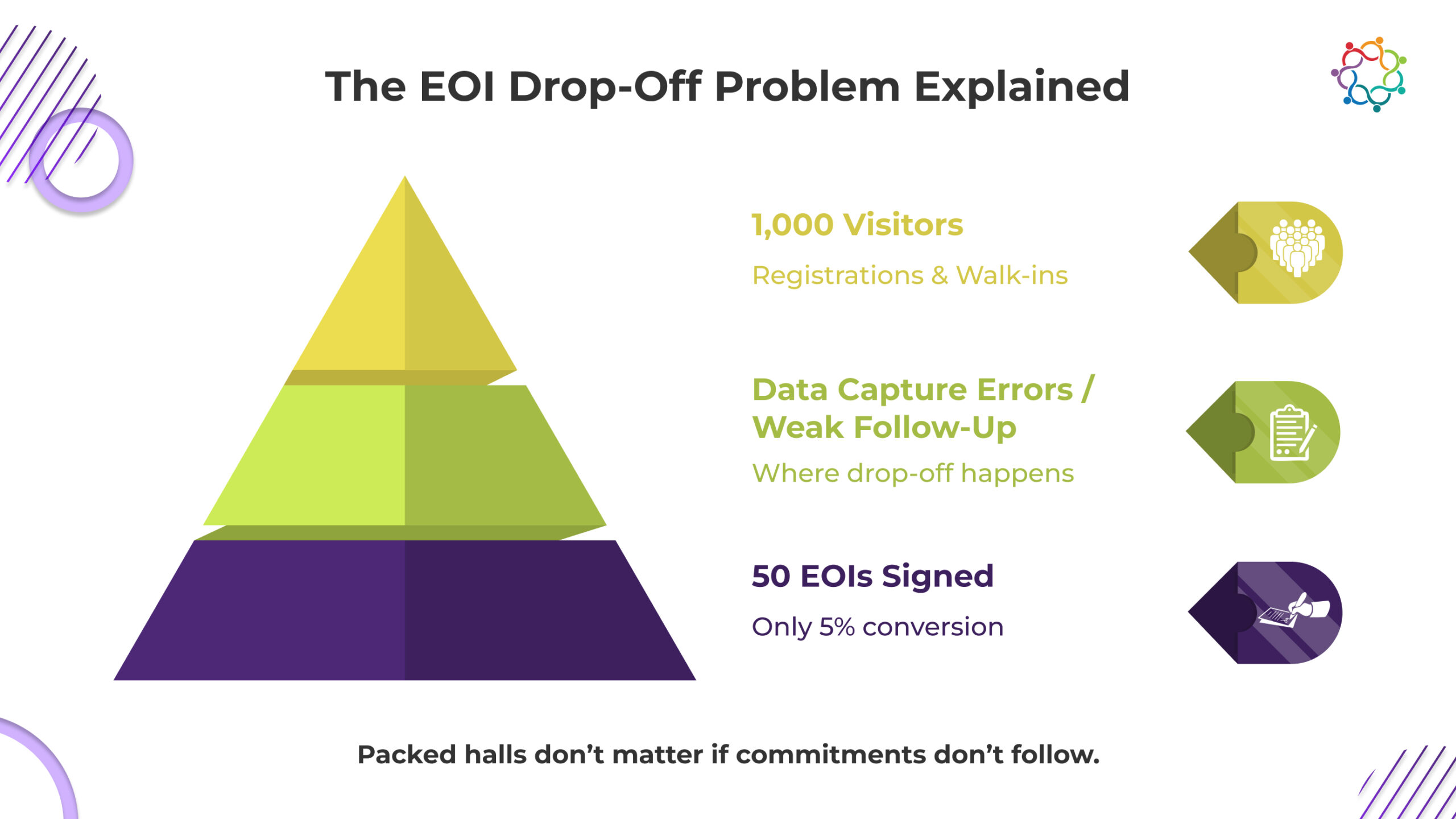
Every real estate developer has been here before:
But once the event ends and you’re back at the office, the reality sets in: the number of signed EOIs (Expressions of Interest) is far below what you expected.
The “drop off” happens for a number of reasons:
For example
1000 attendees walk into a property expo of which 200 stand at transactional booths and of those 200 only 50 sign EOIs. In terms of conversion this means a 5 percent conversion rate, which is very low given the amount of time, money and energy spent just to get 50 EOIs. Now it also becomes exponentially wasted – not just EOIs lost but lost revenue opportunities which you will never be able to recapture.
EOIs represent much more than a buyer’s intent. For a developer, they are a direct indicator of the strength of the sales pipeline. Each EOI reflects a buyer who has already moved through most of the purchase journey, from leaving home to attend a site visit, to seriously considering the project, and now being on the verge of signing a sales agreement.
That’s why low EOI numbers are a serious concern. When conversion levels drop, a developer faces three interconnected risks:
In today’s hype-driven and highly competitive real estate market, buyer interest shifts quickly. Projects don’t just compete on price; they compete on speed of response and credibility. In this environment, every missed EOI essentially equals a missed sale.
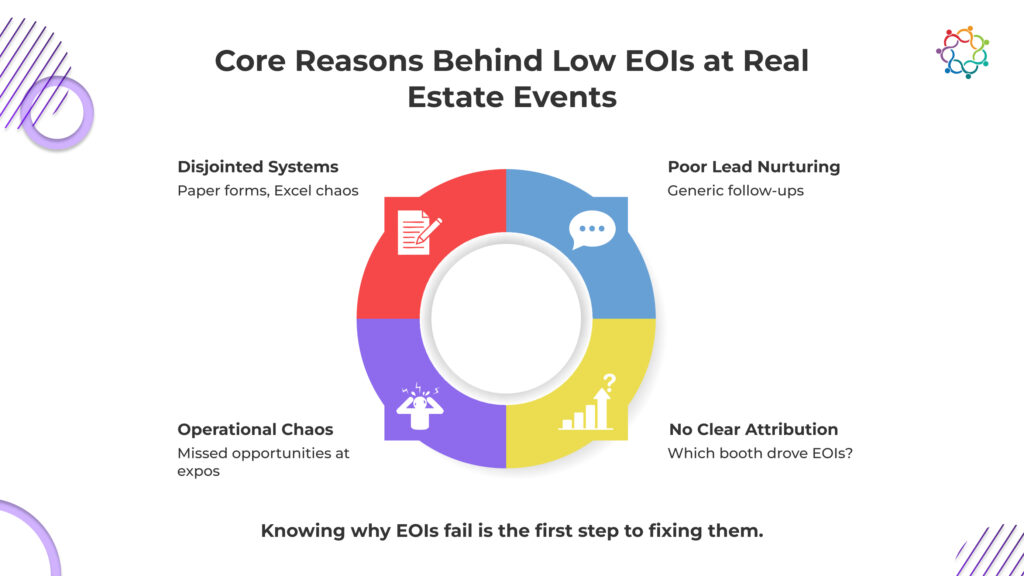
If EOIs are that valuable, why do developers not follow up and gather EOIs?
The issue typically comes down to structural inefficiencies.
As a result, they have a leaky funnel, while they capture attention, intent leaks away.
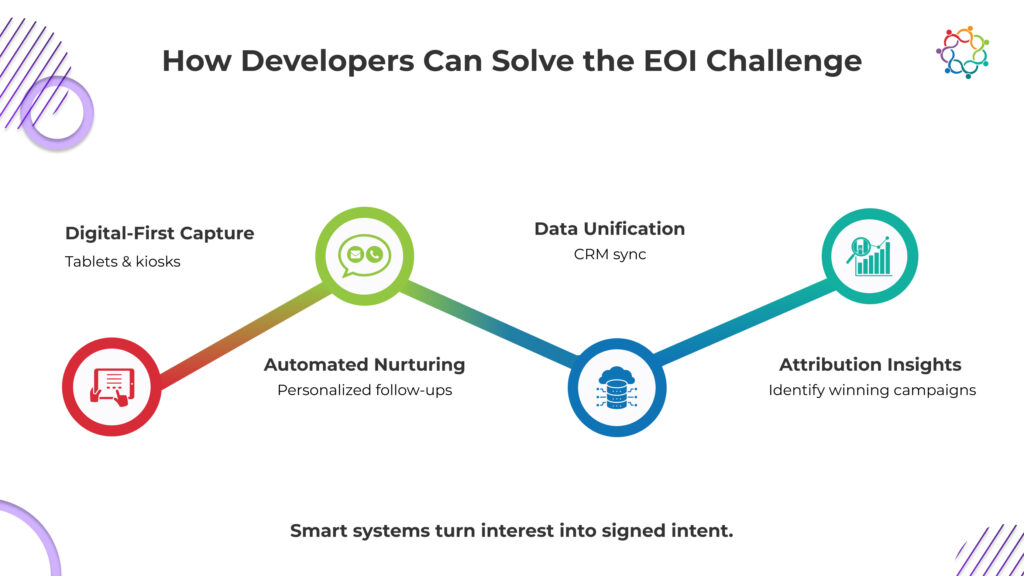
Fixing the EOI problem requires developers to begin to rethink their real estate events marketing as technology-driven, funnel in nature. The fix is in four core strategies.
Collectively, the above items can take your events from being crowd-pleasing showcases to pipeline-driving engines.
This is where Samaaro comes in as a specialized real estate event marketing platform. Developers no longer have to manage different systems or manages which portion of their event was most effective. Samaaro has created a single, combined solution with EOI capture and conversion in mind:
With Samaaro, EOIs shift from being a manual afterthought to a predictable, measurable growth lever that drives sales.
To see how these strategies work in practice, consider Samaaro’s work with a real estate giant in Bangkok. They streamlined EOI collection and queue management using digital forms and real-time CRM sync. The result: 30% more EOIs, faster follow-up, and improved partner accountability. Read the full case study here.
Currently, real estate events are no longer about just filling a venue with footfall. The true success of the event depends on your ability to move them from curiosity to commitment, and it is the EOI that builds the bridge to this completion. Developers who fail to capture and nurture their EOIs properly are throwing away budgets, losing sales to competitors and dealing with irrational cash flow.
The answer is simple: treat events as a structured conversion funnel and change your approach to a digital event suite. With effortless capture, automated nurture and treatment of data and attribution, developers will turn real estate event marketing into a predictable source of revenue.
Those who become successful in the EOI in real estate do not come back happy because they attracted a great crowd. They come back enjoying consistent pipelines and consistent growth.
Are you ready to maximize EOIs at your next event? Ask about what Samaaro’s real estate event solution can bring; we turn your events crowds into close opportunities!
If you ask any event marketer what they do following a successful conference, seminar, or customer workshop, you will typically receive the same answer: reporting. But the reality is that post-event evaluation feels like an overwhelming task to many teams.
Why? The answer is straightforward: events generate enormous amounts of data – registration data, attendance figures, survey results, social media mentions, and revenue figures. Without a structured approach, reports quickly turn into documents heavy with data in PDF form, with nobody reading them, and the insights often not informing future strategies.
In fact, evaluation should not be about collating data. It should be about creating meaning out of that data and using those insights to create better vehicles for value in the next event. This is where having a clear and structured approach is invaluable.
In this blog, we provide a five-step framework for post-event evaluation. By implementing this framework, event marketers can create clarity out of confusion and use their evaluations as a continual improvement engine for their event portfolio.
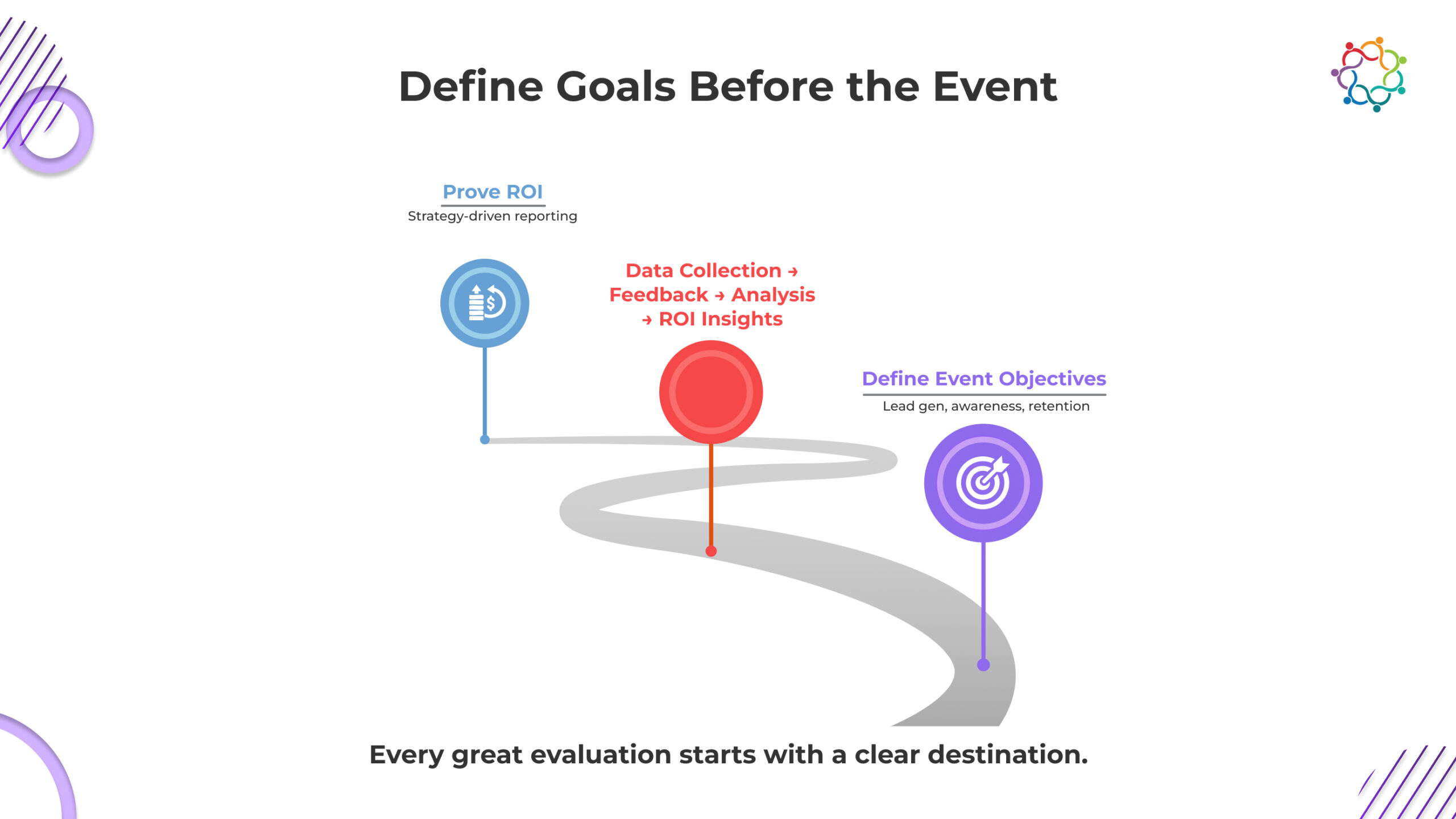
Good evaluation starts well before the event. Without solid goals, post-event reports will have little meaning and will often just serve as vanity metrics.
Think about it: what does success actually look like for this event? The answer will be dependent upon your business priorities.
here are some examples of different goals that are relative:
– If your goals were ROI-oriented: revenue, cost per lead, sponsor ROI
– If your goals were Engagement oriented: session attendance, responses to surveys, participation in live Q&A’s
– If your goals were brand: awareness lift, thought leadership visibility, media mentions
– If your goals were pipeline :leads generated, deals influenced, opportunities accelerated
From your goals you will create specific KPIs. For example, if your goal is demanding generation then your KPIs could be number of MQLs (marketing qualified leads), pipeline, and cost per lead.
The key is alignment. When your event goals and KPIs connect directly back to larger business goals, post-event reporting will be relevant to your decision makers instead of a collectible document that sits in a silo.
Once the event has wrapped up, the next stage is collecting data – and this is when lots of teams over-focus on the numbers assigned to the work, and forget about all the human input involved. A quality evaluation includes both quantitative- and qualitative-based data.
Qualitative data includes:
Why does this balance matter? Because quantitative data tells you what happened, qualitative feedback explains why it happened.
For example, your report may be showing that participants drop off in the afternoon sessions. Qualitative feedback will help you understand why: the schedule was too full or timing wasn’t good for international attendees. Without examining both perspectives, your insights will not be comprehensive.
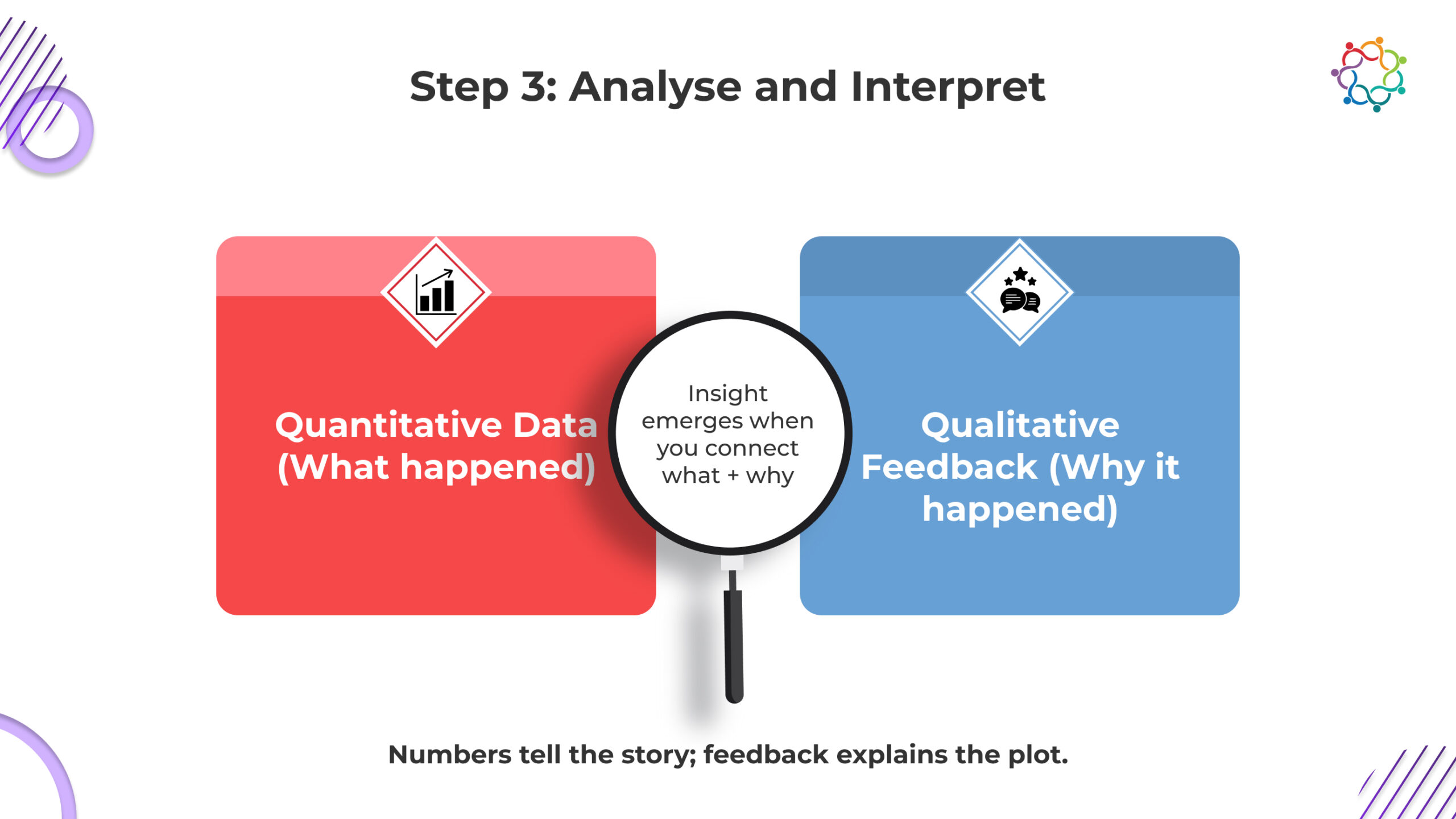
Data collection is only useful with the right analysis. This means you need to pinpoint your findings by recognizing trends, noting deviations from the norm, and connecting the findings to overall objectives.
Did some channels lead to more registrations than others consistently? Were some content items (panels or keynotes) higher in engagement?
Where were you failing? Did sponsors appear to be unhappy? Was there a lack of engagement from a certain geographic region?
Is there a reason why one campaign performed poorly while another one was exceeding expectations? Did the timing, messaging, or targeting differ somehow?
Here’s an example: Let’s say in your report you noticed that the attendance at your event was lower than expected (60%). The report could easily end there but please take it a step further. You might go through feedback and discover that multiple registrants from the APAC region could not attend because the session times did not work with their work times . At least you now have that as a tangible improvement point for your next event.
Numbers are the “what” but the analysis of what happened, in conjunction with feedback is the “why” you are going to formulate strategy.
A solid post-event report is not just a data dump but a structured storytelling exercise, what digs into important details for each stakeholder. An operational structure might consist of:
The intention is to write a report that matters but is focused. Senior-level leadership and stakeholders do not need 30 pages of raw data. They need a sense of success, what worked, what didn’t work, and recommendations for next steps.
Using dashboards, infographics, and visuals can not only make for a more engaging report but provide an easier read for stakeholders.
One of the most common pitfalls teams fall into is acting only when the report has been delivered. The opportunities for learning from an event should not stop upon delivery of the report – we need to “feed” insights that generate learning into the next cycle of planning to affected future strategy.
Some examples of changes driven by insights are as follows:
This step is making evaluation, remediation and planning into an ongoing cycle of evaluation. Therefore, improving each event beyond the last!
Think about a B2B SaaS company conducting their annual customer summit. They defined their goals as lead generation, customer retention, and positioning themselves as thought leaders in the community.
This framework allowed them to use their data and avoid a generic review of their summit and make a strategic plan to improve for both tenants and sponsors the following year.
Though the 5-step process seems like a manageable system, executing it manually is a significant time, energy, and resource drain. Samaaro provides a way to operationalize each stage of the 5-step process.
By allowing event teams to collect data, analyse results and develop reports in one place, Samaaro is focused on highlighting ways to pivot from simply gathering information to strategically applying that which was learned through the process.
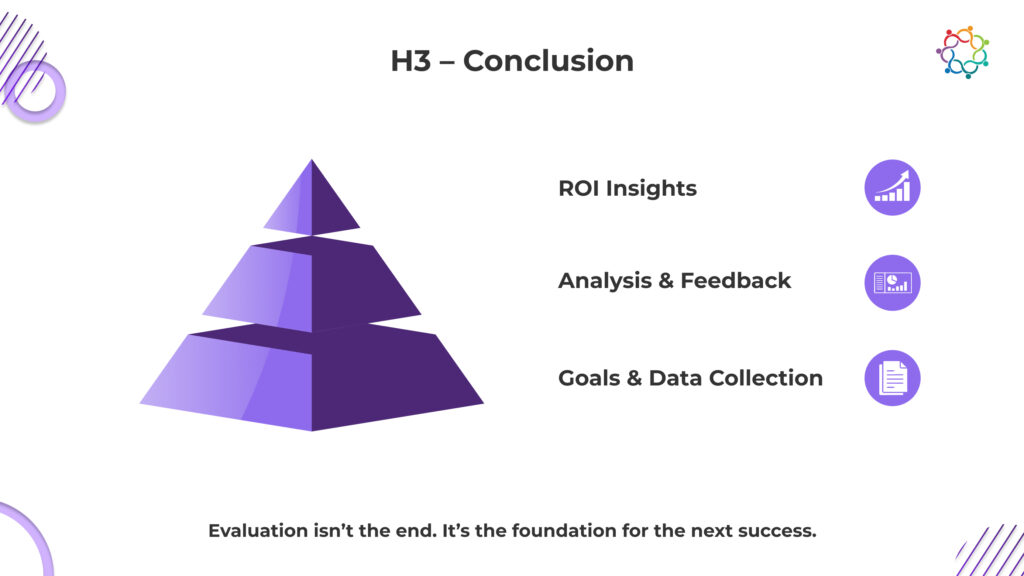
Post-event evaluation doesn’t only concern the past, it helps to define the future. Time after time, teams become consumed by a sea of numbers and fail to ask the important questions: What do these learnings mean, and how can they support betterment?
When marketers suss out the evaluation process into 5 parts, establish objectives, gather data, finalize learnings, prepare reports, and utilize recommendations, then reporting is an after-thought, not an after-event report.
Structured evaluation ensures that each event is smarter, more efficient, and more effective than the last. And with development tools like Samaaro, taking feedback and rendering ROI insights is not just possible but easy.
Would you like an ‘off-the-shelf’ evaluation model? Download our Post-Event Evaluation white paper or analysis how Samaaro is moving event organizers from feedback to ROI insights.
Heading into 2025, audiences in the B2B space are more fragmented than ever. Decision-makers don’t just reside in one space online, they are consuming industry news, browsing LinkedIn, skimming newsletters, and engaging with private communities. This means only promoting an event on one channel, is no longer sufficient.
An effective B2B event promotion strategy involves a multi-channel mix that balances reach, trust, and conversion power. Internal channels are the foundation, organic channels add credence, paid campaigns increase reach, and partner programs offer a third-party validation. When combined in a multi-channel event promotion strategy, these 4 components offer a maximized ROI while ensuring no audience segments are left behind.
The real question is not which channel is best, but which mix of channels will work best to achieve your event goals. Let us evaluate the best suited B2B event promotion channels at this stage of events in 2025, and ways you can use them purposefully.
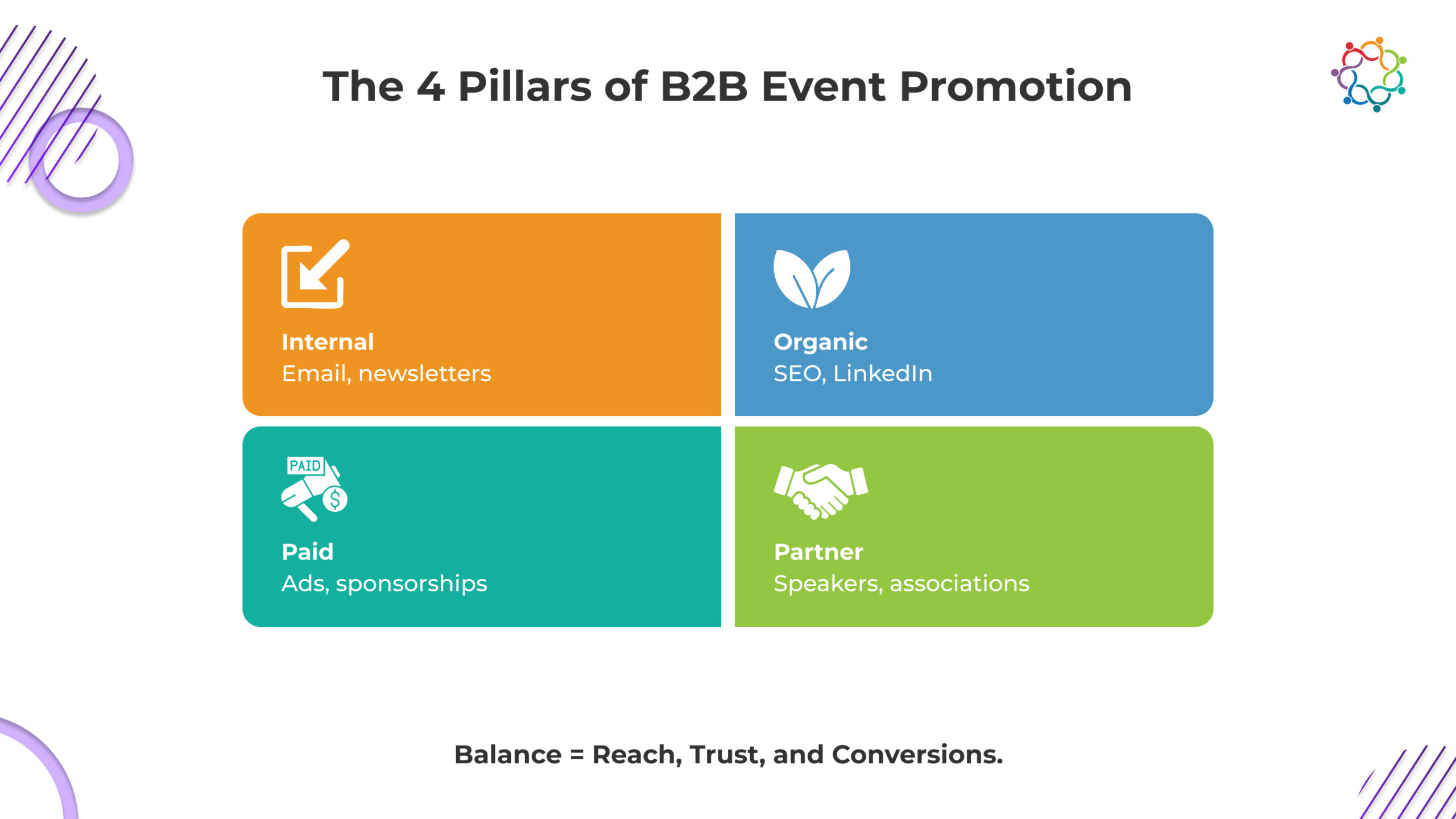
Internal channels are often overlooked, however, they are the best place to promote B2B, and they are already owned assets. It comes down to your existing CRM, employees, and customer channels.
Email is still one of the best ROI channels for B2B events. The ROI is even better if you segment your lists based on prior attendee history, position, or engagement level so you can do more personalized outreach. Example: “Hey, since you attended our AI Summit last year we would love to invite you to this year’s on enterprise automation. ”
Your employees, and especially your leaders, provide trusted voices to reach on LinkedIn. Ask your employees to share event media, speaker announcements, blog posts, or behind the scenes event prep and this can really grow your organic reach and create authenticity.
B2B buyers are already viewing updates from you via these channels. If you make a habit of promoting your events consistently in your monthly newsletters, and via a customer portal, this will stay top of mind without cost or management of a promo campaign.
How Internal Channels Are Better: They’re trusted, personalized, cost-effective, and an easy environment to generate a base of registrations before advancing to external campaign promotions.
Organic channels require time to produce results but communicate sustainable visibility and credibility, which are both core foundations of B2B events.
Publishing SEO optimized articles that closely relate to your event theme means organic traffic towards your subject and all whilst attracting industry authorities/stakeholders looking for answers. This is justified in the example article, “The Future of Enterprise AI in 2025,” that recently published, a mixture of thought leadership but by also providing a promotion for the event, AI Summit.
Following speakers, executives, and subject-matter experts provide a massive value. Using previews of your sessions, industry insights, outlining “why we are excited about this event” previews, building authority, and developing anticipation leads into your event.
Besides LinkedIn, I believe Twitter (X) & Instagram Stories (and other platforms) can provide previewing utility; feeding into social-media-saturation while sharing and documenting behind-the-scenes of your preparation, interviewing speakers, or teasing your event. This provides additional touch points for continued familiarity.
The Power of Organic Channels: For B2B marketing in lead generation for examples, one of the biggest strengths of organic channels is the authority and inbound discovery, with leads being generated and attracted by your content even after the event concludes.
Paid channels are the fast track to your campaign, giving speed and precision at scale.
The gold standard B2B targeting mechanism there is. Filter by role, seniority, industry, geography, and company size; it’s guaranteed every rupee you spend will be delivered to the right audience. Best used for lead gen campaigns connected to early-bird registrations.
Great for providing a reminder to warm leads that visited your event home page but didn’t register. Think of your ad as a friendly reminder, bringing prospects back into the funnel as they consider registration or ticket purchasing.
Most industries have trusted newsletters or media outlets that provide high engagement traffic. Use sponsored placement in these newsletters to focus your advertisement and develop some credibility and relevance around your event and promoted content to come. This strategy is especially effective when engaging niche verticals.
Advantages of Paid Channels: Offers scalable reach and measurable ROI but does take some discipline to manage your budget and not overspend.
Trust is currency in B2B. Partner channels lend credibility and can broaden access to audiences outside of your normal reach.
Often, invited speakers come with large professional followings. If you can enlist invited speakers to share promotional content they will effectively bring your event into trusted peer networks.
These stakeholders have skin in the game. With a coordinated campaign (a co-branded post, an email blast, etc.) they amplify your promotional stakes.
Associations and trade media carry authority credibility. Their endorsement signals credibility, and that attending your event is a must-attend for industry -it creates event FOMO in your audience.
Importance of Partner Channels: They provide a combination of third-party validation and reach, which is critical in establishing your event as an industry leader.
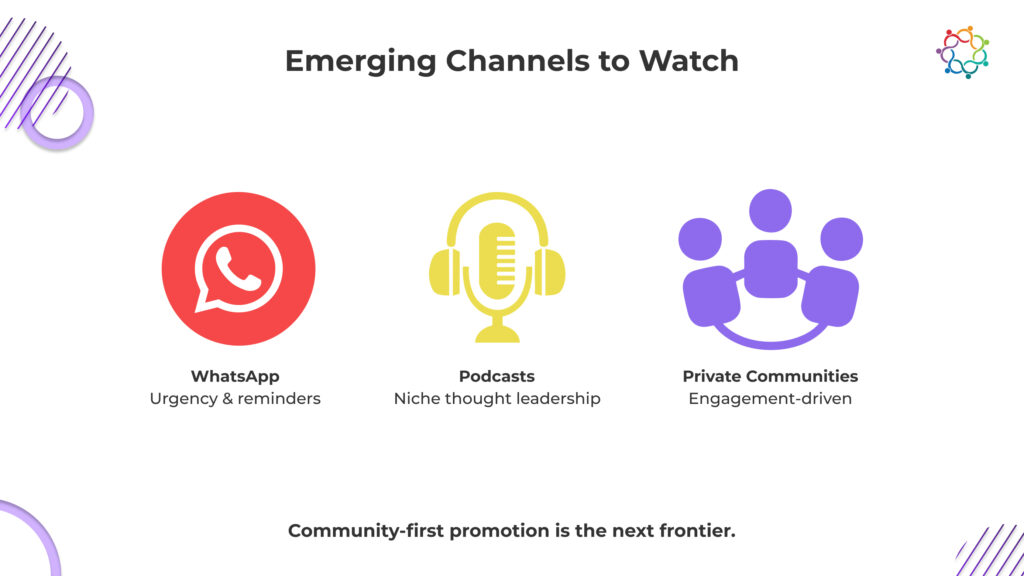
While the four pillars are key, there are many new channels that are changing the way B2B marketers will promote their events.
Direct- it’s personal and urgent. Ideal for reminders (“Only 48 hours left to register”!) or VIP invites.
Podcasts provide a great opportunity to engage with decision makers through storytelling and thought leadership. For example, have a featured guest appearance from the CEO based on the event theme.
Closed, high-value communities are the final frontier for B2B engagement. Simply taking an authentic (emphasis on authentic) role in these spaces begins to build relationships that will translate into registrations.
Trend: A focus on community-first outreach, which is driven by peers, as opposed to “mass push” tactics.
Since every event has its own goals, audiences, and budgets, determining the best channel mix involves matching the channels to your event type and goals.
The key is balance: budget, audience, and event type should dictate how much weight you give to each channel.
As 2025 approaches, there still isn’t a “best” B2B event promotion channel. The winners are the teams that effectively blend owned trust, organic credibility, paid precision, partner amplification, and experiment with new frontiers like WhatsApp, podcasts, and private communities.
The message is simple: diversify or risk being irrelevant.
When building out a multi-channel strategy with the right tools to measure effectiveness, B2B marketers can ensure their event will not only reach the right audience but will also be able to demonstrate measurable ROI.
Interested in a further breakdown of internal, organic, paid, and partner promotion strategies? Please, download our Event Promotion white paper or explore Samaaro’s channel attribution capabilities today.
Post-event reporting is too frequently treated as an afterthought. Teams throw together some numbers in a slide deck, check the “report submitted” box, and move on. But that approach misses the opportunity to unlock the true power of reporting.
A post-event evaluation report that’s well done is more than just a recap; it is a strategic document that goes beyond event activities and draws the connection to business results, advises leadership on future decisions, and provides insight into both past performance and the future campaign. When done well, the report vehicles learning and growth and is an ongoing road map for continuous improvement, not merely a rear-view mirror that reflects on your last event.
The objective of this blog post is straightforward: to help you move from data-dumping to decision-driving! We will review the steps to build an evaluation report that is structured, has some balance and still accounts for the perspectives of executives, marketers, and event teams.
The bedrock of any solid report is your established goals and objectives before the promotion of the event ever begins. If you don’t set goals and objectives, your report will not only lack direction and it will also be a collection of uncontextualized numbers – way less than useful!
When establishing goals and objectives, make sure to tie them to specific, measurable KPIs. For example:
Example:
If the objective of your event was to “grow enterprise pipeline by 15%,” then your report should include measurement of: total number of leads, conversion %, opportunities created.
By connecting your goals with data categories upfront, you essentially ensure that your report answers the most important question for your stakeholders: “Did we achieve what we set out to do?”

Your reports should encompass the complete narrative, information has both numbers and narratives.
Why does this matter: Quantitative tells you what happened, qualitative tells you why it happened. For example, if the keynote had low attendance, the qualitative might help us determine why. The title was not compelling enough or clashed with another popular session.
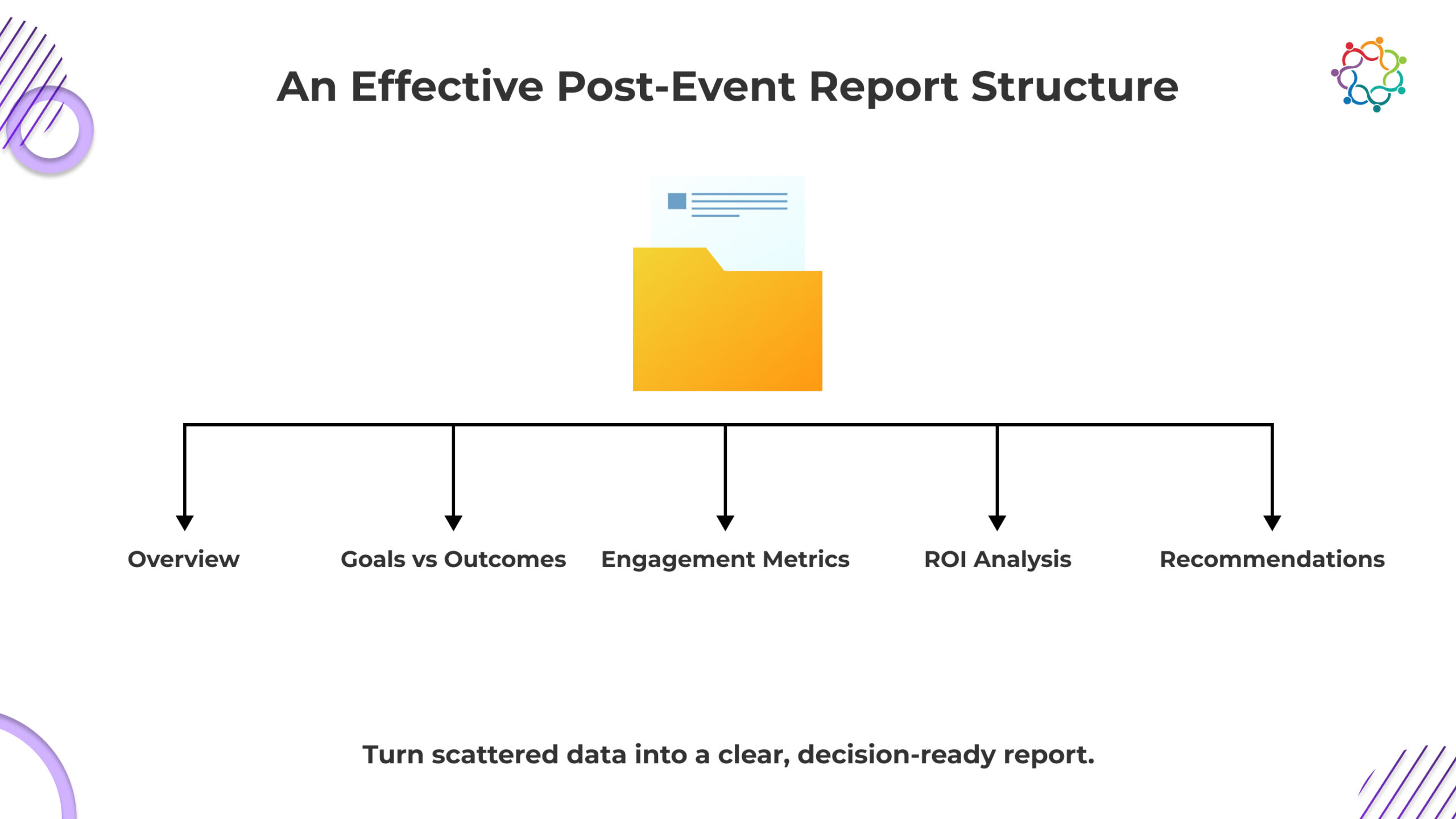
A great report is a structured story, not a data dump. A report divided into sections will help stakeholders find the information that they most care about.
Suggested post-event evaluation report structure:
This flow ensures that your report will answer sequentially the typical questions: what happened, how successful was it, why did it happen, and what now?
Numbers alone can be lifeless. Visuals tell the story.
Sample of Visuals to Include:
When you visualize insights, you can morph the report into something that is executive ready and ready to act on.
Not all stakeholders want the same level of detail. A good evaluation report should be tailored for the audience you are sharing it with.
Tip: Create a master report then use it to make a condensed version for different teams, this will ensure the relevance for each audience while avoiding overwhelming them with too much information.
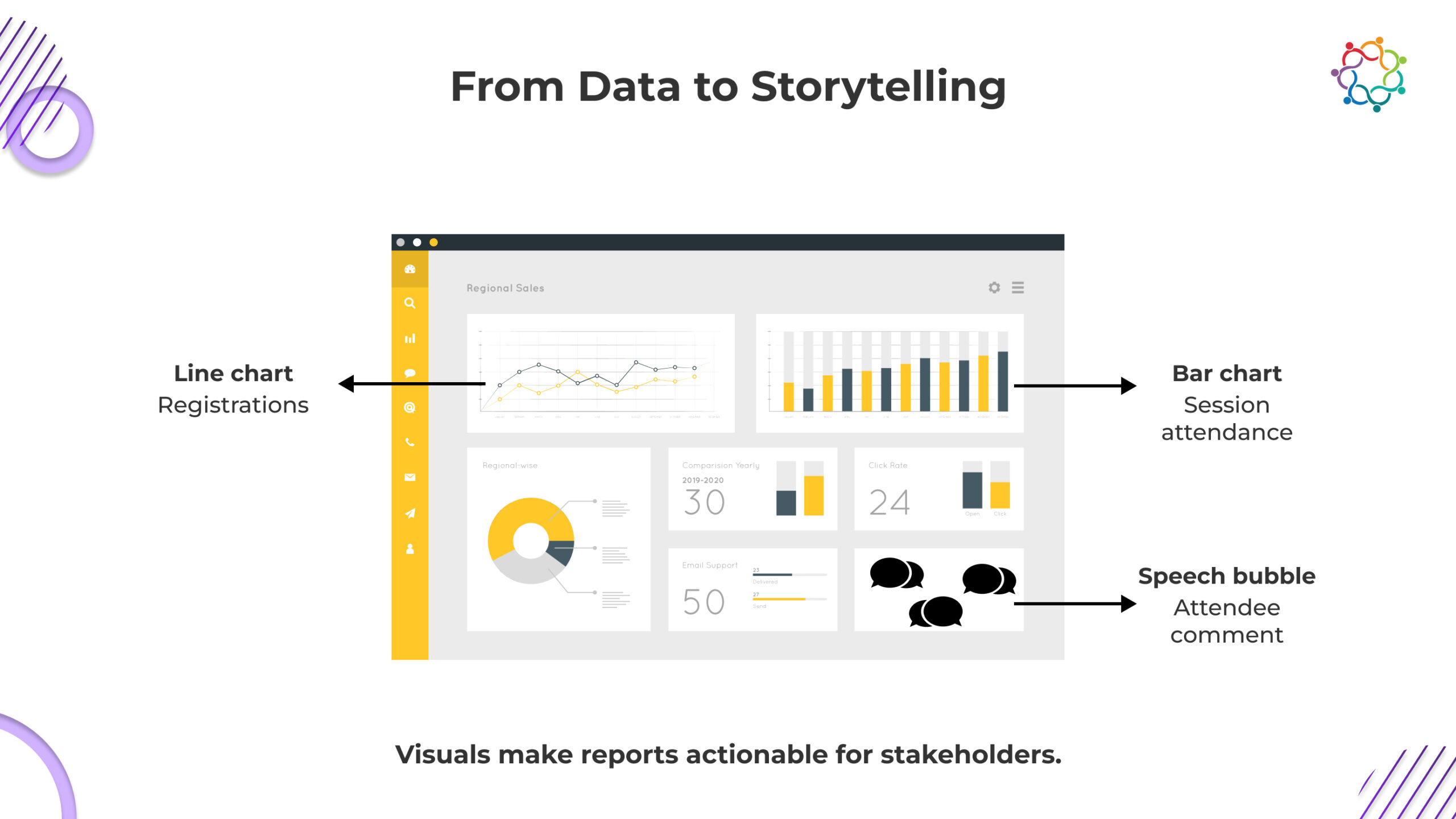
Let’s make this practical with an example template you can adapt:
This kind of structured template turns data into a usable narrative.
Samaaro simplifies the evaluation reporting process through:
Instead of weeks pulling together data, Samaaro users produce executive ready reports in a matter of hours.
A post-event evaluation report is not just a formality; it is a strategic resource. When developed effectively, it tells the complete story of an event, outlines ROI, and outlines actionable steps to improve future outcomes.
The formula is simple: set objectives up front, balance quantitative and qualitative data, develop the report with a clear structure, visualize key insights, and customize the report for audiences/stakeholders.
For organizations that run multiple events a year, these reports become the institutional knowledge that can be used as a playbook to repeat success year over year.
Does the evaluation process sound overwhelming? Download our Post-Event Evaluation white paper or explore Samaaro’s reporting capabilities today.
When marketing events, most marketing teams work hard but not always strategically. Most event campaigns just end up being reactive and fragmented through multiple channels or favoured because whatever tactic they are currently engaged in, or feel is the least effort. As a result, some of the best events fail to meet their attendance and ROI goals.
This is where the 7P model of marketing can help. The 7Ps were developed to broaden the original 4Ps (‘Product’, ‘Price’, ‘Place’, ‘Promotion’) and provides a structured approach to properly analyse every decision made during an event campaign. More specifically, this model can both establish promotion as a repeatable and comprehensive approach versus being left to chance.
This blog will provide clarity regarding the 7Ps: Product, Price, Place, Promotion, People, Process and Physical evidence as it pertains to event marketing, and how enterprise can use this model to create ongoing, impactful campaigns as we move into 2025.
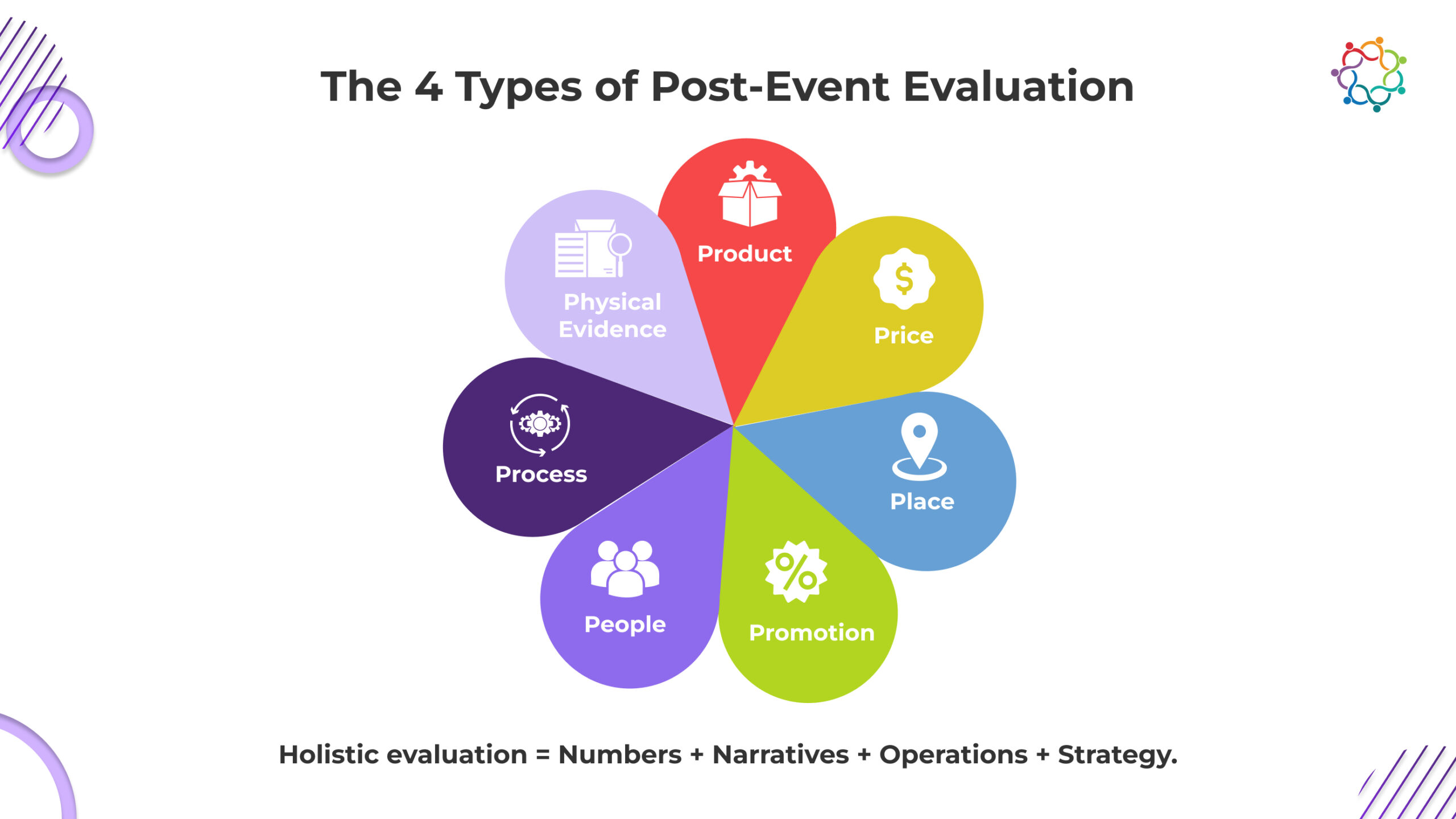
The 7P model evolved from the classic marketing mix. The first 4Ps (Product, Price, Place, Promotion) focus more on tangible product goods, but the 7Ps add three more elements: People, Process, and Physical Evidence, for a deeper exploration of the particulars of service-based industries.
By its very nature, events are experiential products. They bring together both tangible (venue, speakers, ticketing) and intangible (learning, networking, branding) elements. This makes the 7Ps an especially useful framework for promoting events as it incorporates all elements of logistical and perceived value.
In simple terms: The 7Ps help marketers make sure every base is covered when they design event marketing campaigns, so they do not forget any important parts of the campaign.
Let’s break down each “P” and how it translates into event promotion strategy.
The event itself is really what makes up any campaign. By “product,” we mean the experience, the content, and the format being sold.
For example: A B2B SaaS (software as a service) conference should define the product as a learning hub for industry best practices, discovering innovation, and meeting with enterprise buyers.
Price is not just a number in an event; it establishes the expectation of the perceived value of the event.
Example: A VIP pass offering private networking and dinners with speakers increases perceived exclusivity, while also enabling another potential revenue stream.
“Place” is no longer just the physical venue but also the passages to access the platforms/sites/or channels that you plan to use for your event attendees.
Example: If your leadership summit is located centrally in a business district, it shows credibility and professionalism. The option to offer a livestream also allows you to cast a larger net.
Marketers tend to focus on just this part of the cycle, but this part is just one piece of the puzzle. Promotion encompasses the methods you use to spread the word and create demand.
The important part is to integrate and not use one channel, but layer them to create campaigns.
People drive events, and events are some of their most powerful promotional assets.
Example: When every speaker posts about your event on LinkedIn, the campaign leverages thousands of relevant followers at no additional cost.
Sleek processes are fundamental to turning interest into attendance. If registration or engagement becomes difficult, the promotional activity may become null and void. With the above in mind, and with a view to reducing unnecessary burden on a potential attendee during registration and/or engagement, consider:
For example; an attendee registering, receiving a personalized confirmation email, receiving updates of relative value in small batches leading up to the event as reminders of intended content, and the schedule of the event. A structured approach/communication, and sequence of communications during this process keeps an attendee engaged.
Tangible evidence gives potential participants a sense of value that can be difficult to quantify.
Example of a landing page with video highlights of last year’s summit, along with testimonials from Fortune 500 attendees, creates trust right away.
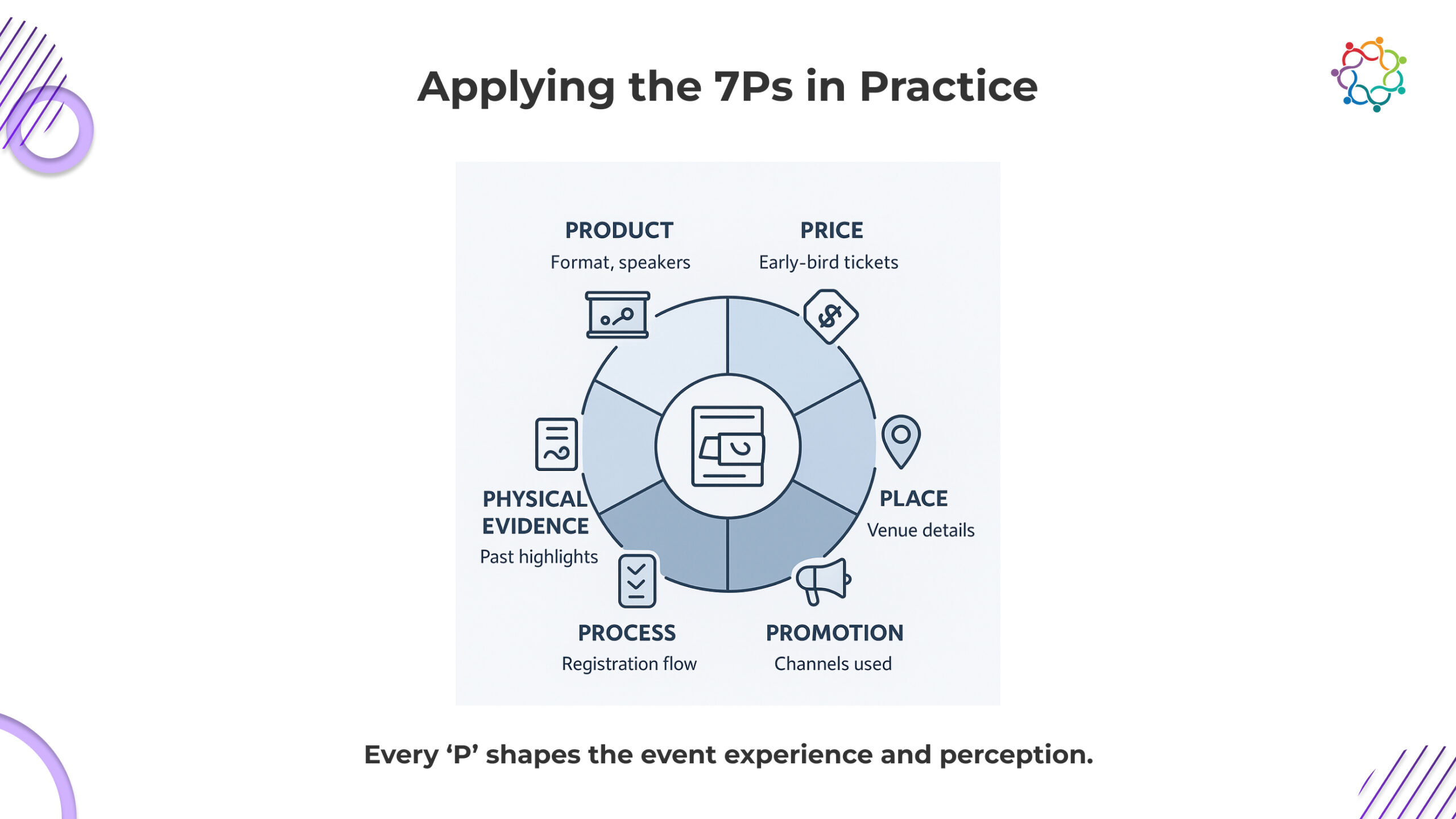
Picture that a business has just run their Annual Leadership Summit. If you are conscious of the 7P’s, your campaign could look something like this:
Only consider the graphics within your campaign
Engaging with this campaign design framework will help ensure your campaign is complete, credible and consistent.
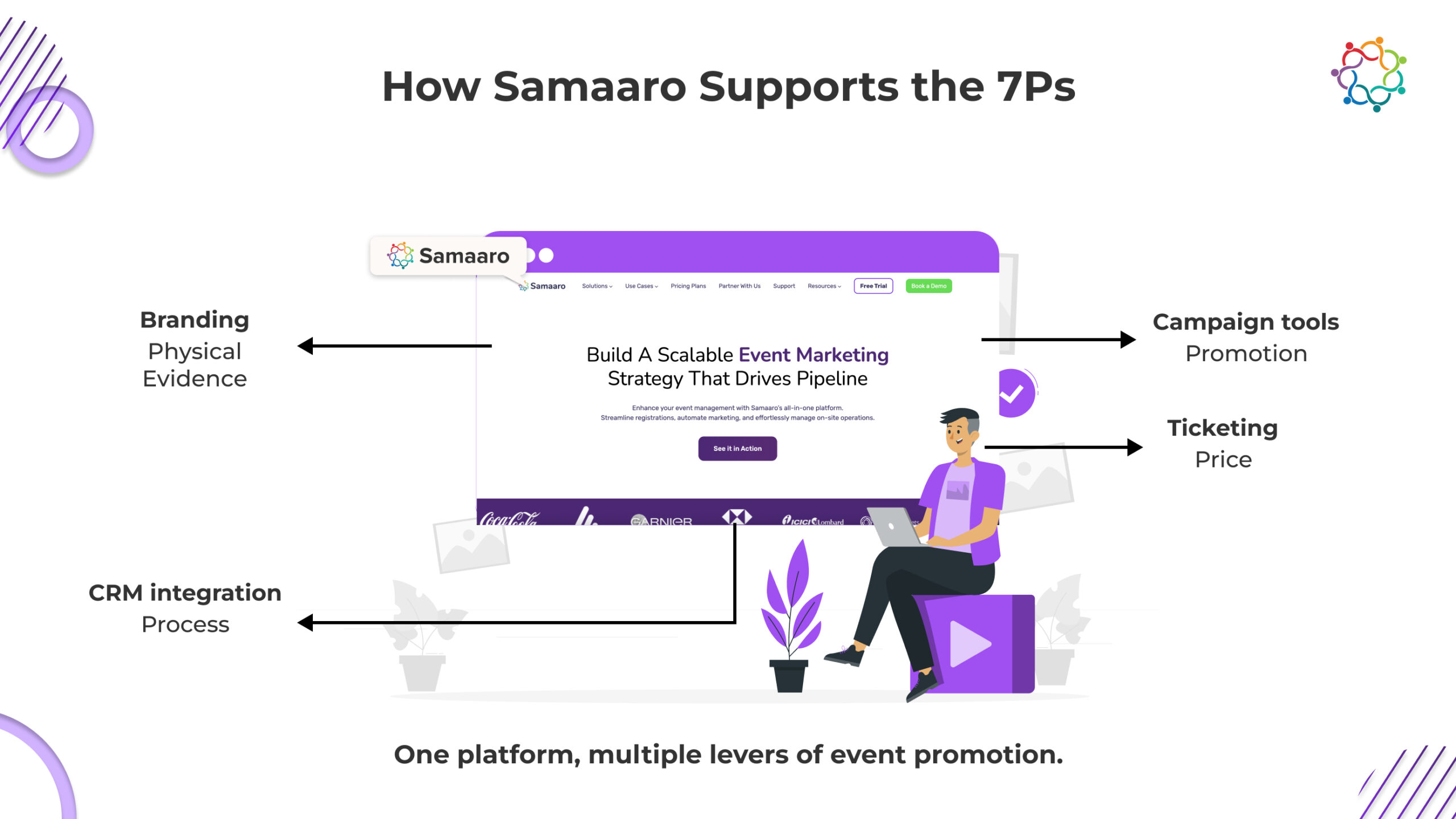
Samaaro’s platform is designed to make each of the 7Ps work in a simple and real way:
Samaaro takes the 7P model out of the theoretical and into a practical campaign tool.
Event marketing does not have to be a frenzy or a guessing game. The 7P model allows event marketers to give structure to the full range of aspects of event marketing depending on the time of year including pricing, promotion, and engagement with attendees.
The real benefit of the 7Ps is consistency: every time a campaign is run, it can be documented, implemented and improved upon based on the previous campaign. This is especially beneficial for companies running multiple events in a 12-month cycle as it allows for sustained growth.
Would you like to learn more about how you can build promotional campaigns using models like the 7Ps? Download the Event Promotion white paper or see how Samaaro makes execution easy.
In the field of event marketing, “post-event analysis” and “post-event evaluation” are often misconstrued as having the same meaning. This blend of two words often means reports that are very data heavy (lots of numeric results) but are also light on insights that can be turned into actions (i.e., there is a lot of detail but not much meaning). In the end, Leadership has a dashboard of data and little idea as what actions they should follow through post-event.
Analysis and evaluation represent two different but related steps in the overall event performance measurement process. One gives the facts and the other the tactical direction as a follow up. By understanding this important difference, you can transform your post-event reporting from a mere summary of what happened to an actionable approach for continuous improvement.
Post-event analysis is when you examine and compile the raw data on your performance. It is a factual and objective examination of what action was taken and the resulting outcomes from an event. This is the phase where you will obtain all relevant measurable outputs and put them together in a report.
Post-event evaluation is the step in the process where you take the data from your analysis and evaluate it against your prior expectations, goals, or targets (whatever you called them). It is the evaluative part of the process where you will draw conclusions and provide an actionable level of recommendations based on the data and information you collected; it takes raw data and then provides meaning and direction.
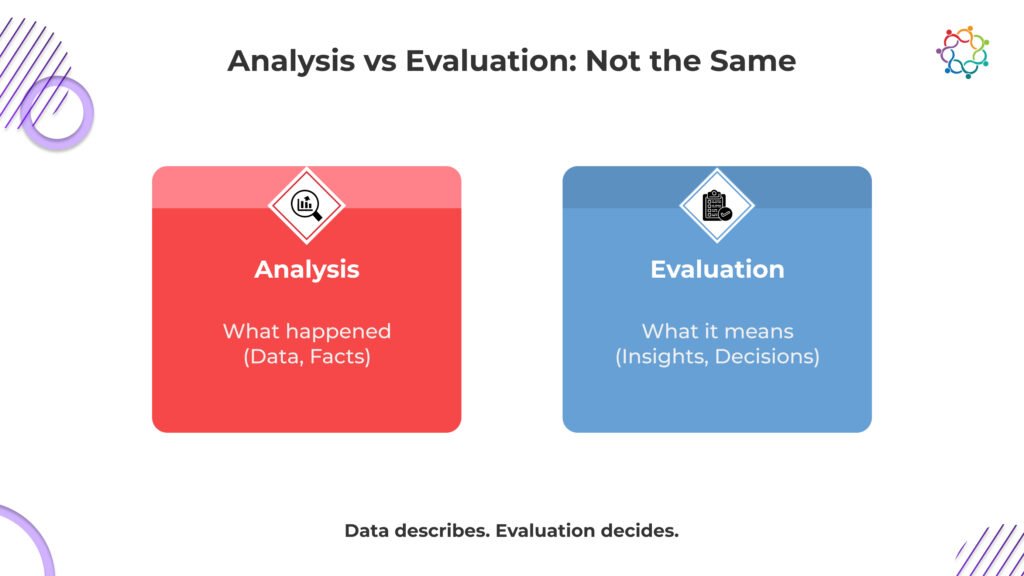
The difference between these two processes can be summarized in a powerful but simple way:
Think about it this way: an event reporting framework begins with analysis and ends with evaluation.
For example;
Analysis gives you the diagnosis; evaluation gives you the treatment plan. You can’t have a decent treatment plan without a proper diagnosis, and a diagnosis without a treatment plan is useless.
The performance measurement for events is not fully complete without both evaluation and analysis.
Combining evaluation and analysis creates a true feedback loop. The analysis provides the evidence and the evaluation uses this evidence to support decisions in the event strategy and provides an organizational justification for celebrating event success.
Common Mistakes Teams Make
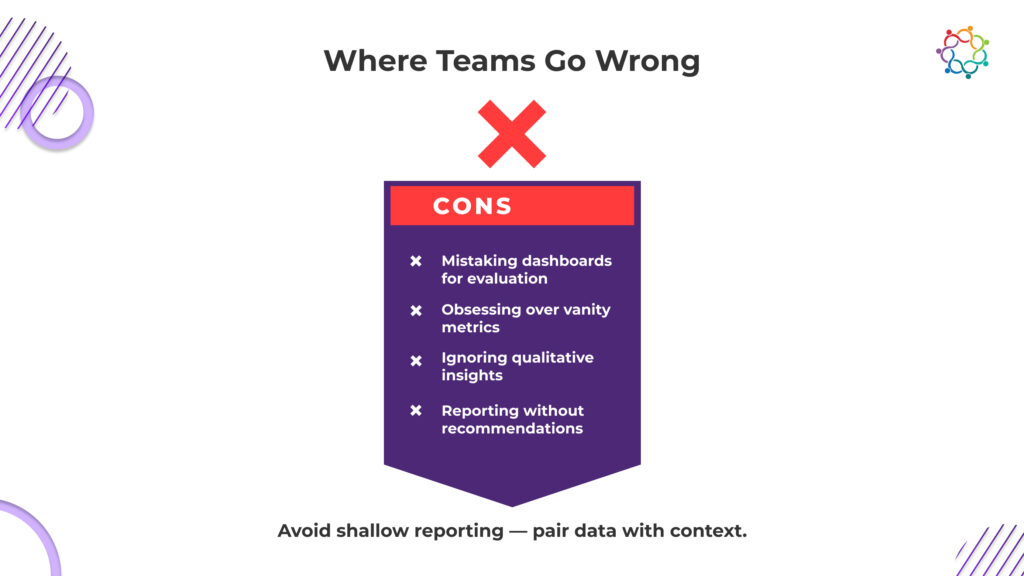
Even when teams are clear on the difference, they still fail to synthesize complete evaluation components. The most common observations include:
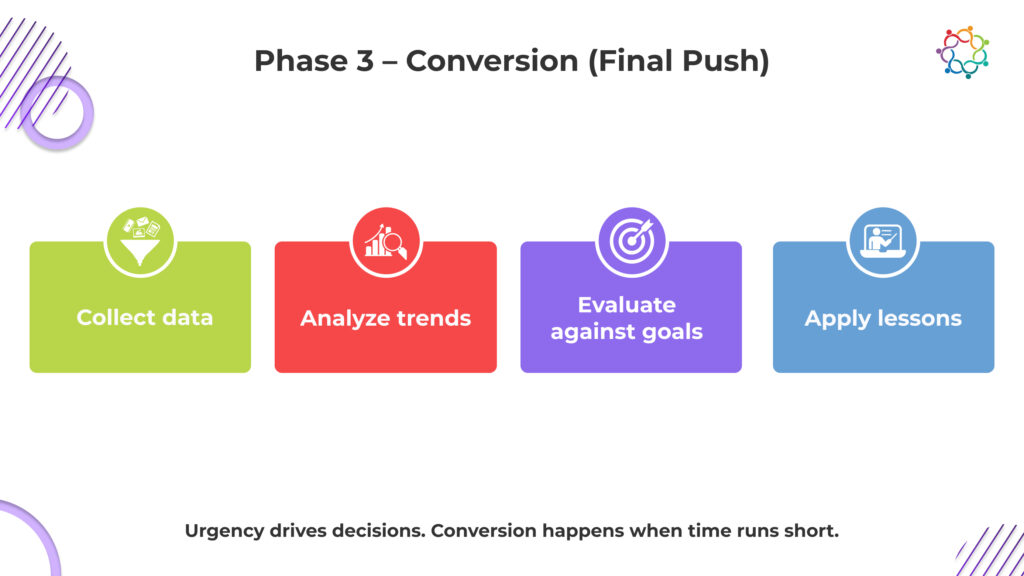
Here is a simple four-step model to assist your team in growing their capacity to better understand best practice for event analysis and post-event evaluations:
Samaaro is designed to effectively connect analysis to evaluation, allowing you to measure your event results in the best way possible.
At the end of the day, the numbers provide a narrative, but evaluation tells that narrative’s moral. The best event teams do not end with “this happened,” but rather ask, “what does this mean, and what should we do now?” Analysis and evaluation help provide unique leverage not only to demonstrate the value of your event but also to improve every event you host.
Want to master analysis and evaluation? Download our Post-Event Evaluation white paper or have a look at how Samaaro works both methods together to show a clear path from analysis to evaluation.
The myth that you can only have a successful event promotion campaign with a large ad budget is an ongoing one. Many event teams (especially teams/individuals at startups, or small to medium-sized businesses) often feel they cannot compete with bigger brands. However, creativity, strategic use of your owned assets and perseverance will help you achieve an incredible return on investment, even with a ridiculously low spend.
Stop thinking about running out of funds as a limitation and conditioning your mind to think in terms of innovation. This guide will act as a play book of sorts for running an event promotion campaign; hopefully you will see that smart planning and clever tactics can be better than large ad spend!
We’re going to explore high value, low-cost event marketing ideas for reaching the right audience without a large investment! We will cover ways to use your existing networks, find great partnerships, and implement marketing tactics to maximise rock-bottom cost for your event promotion.
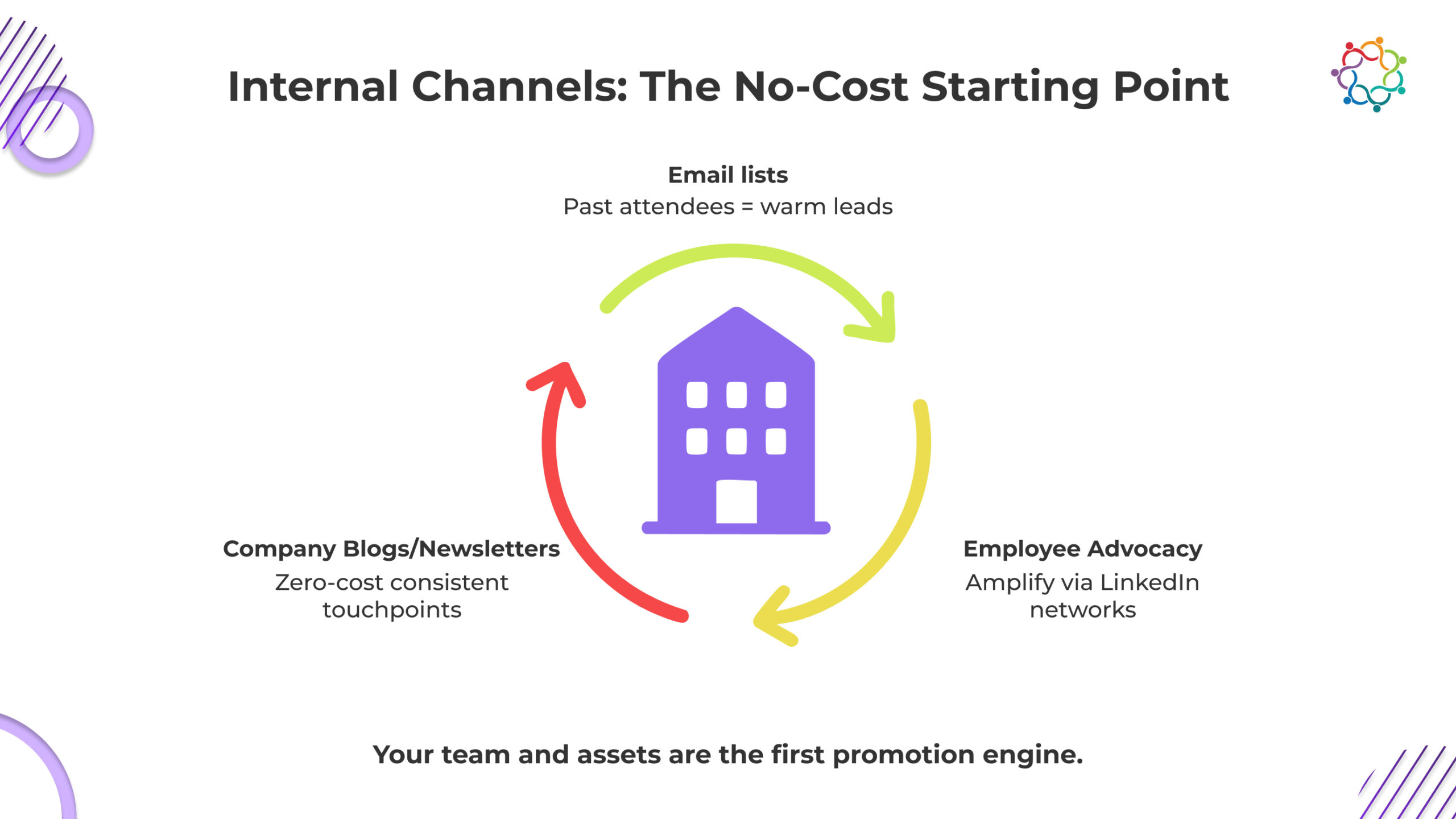
Before you spend money on any paid advertising, take a look at resources you may have available to you, right now. The biggest promotion power has, and likely always will be, your own assets, channels, and resources, and they are often free! These established channels come with built-in trust and a captive audience to promote your event in a cost-efficient manner.
Organic promotion means making content and creating thriving communities without the intention of achieving reach explicitly. Organic promotion will take time, but the long-term impact on your brand and the audience is worth it.
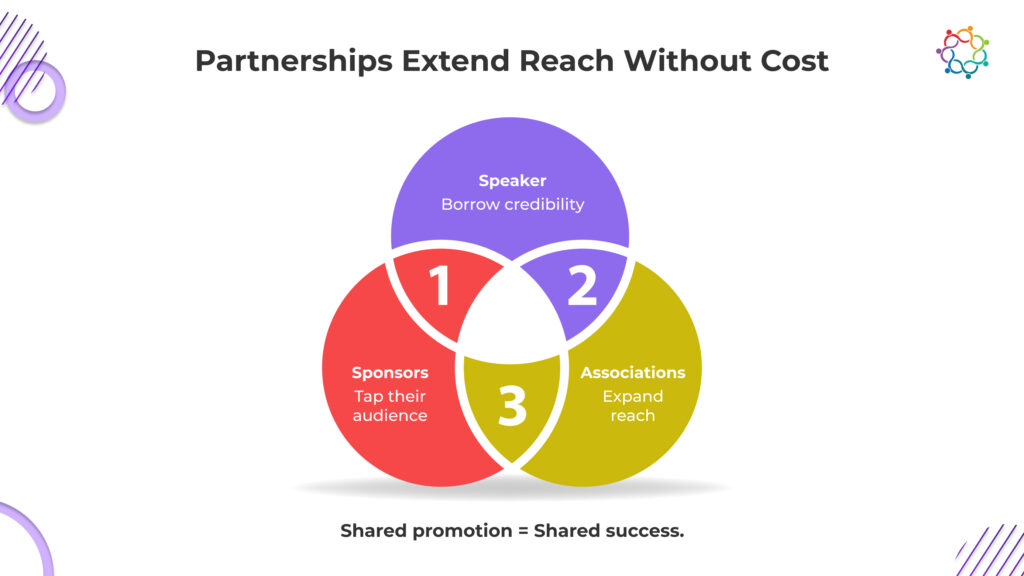
Strategic partnerships are great and inexpensive ways to promote an event that can create a viral campaign out of one promotion. By tapping into the reach of others, you can engage a greater audience with much less expense.
Small budgets can have big impacts with an effective small spend. The good thing is you get to spend smart and not spend broadly and unfocused.
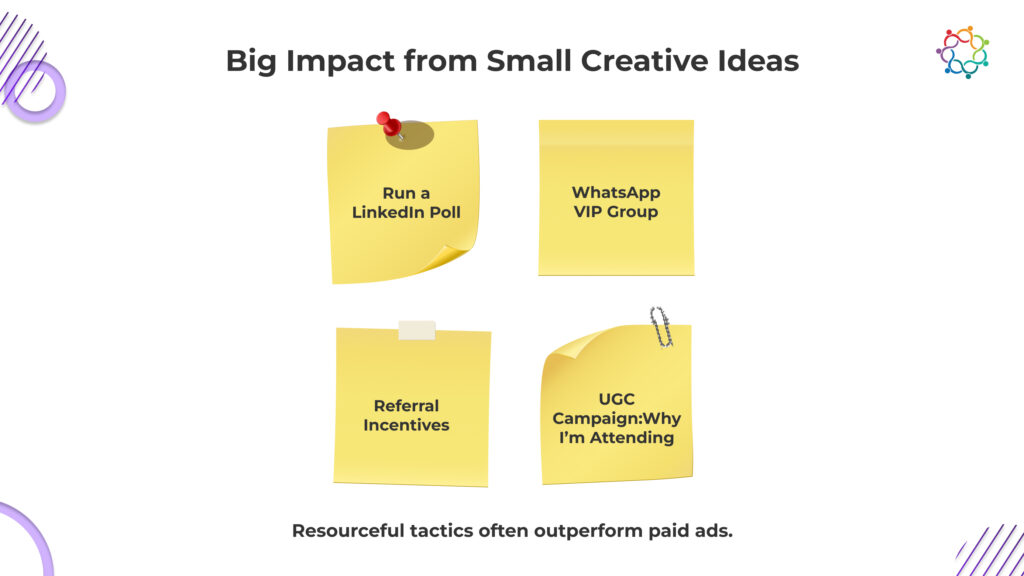
Sometimes the best promotion doesn’t mean needing a budget, only a good idea. These low-cost event promotion tactics will rely on creativity and knowing your audience.
When you have a small budget, you really must prioritize.
Samaaro was built with the philosophy of maximizing value and doing more with less; using your limited budgets effectively. Samaaro has a robust platform with features built-in that eliminates manual work to help you get the best return on every rupee you spend.
A tight budget is not a roadblock when planning an effective event promotion plan; it’s a chance. By developing a smart and economical event promotion plan, a budgetary limitation can turn into an opportunity for creativity and resourcefulness.
With a combination of owned channels, most impactful, organic approaches to promotion, and thoughtful, collaborative partner promotion – small teams can create big impact. Don’t forget it’s not about spending more, it’s about spending smarter.
Want more ideas to help contain costs? Download our Event Promotion white paper or learn more about how Samaaro helps ensure you maximize every rupee spent.
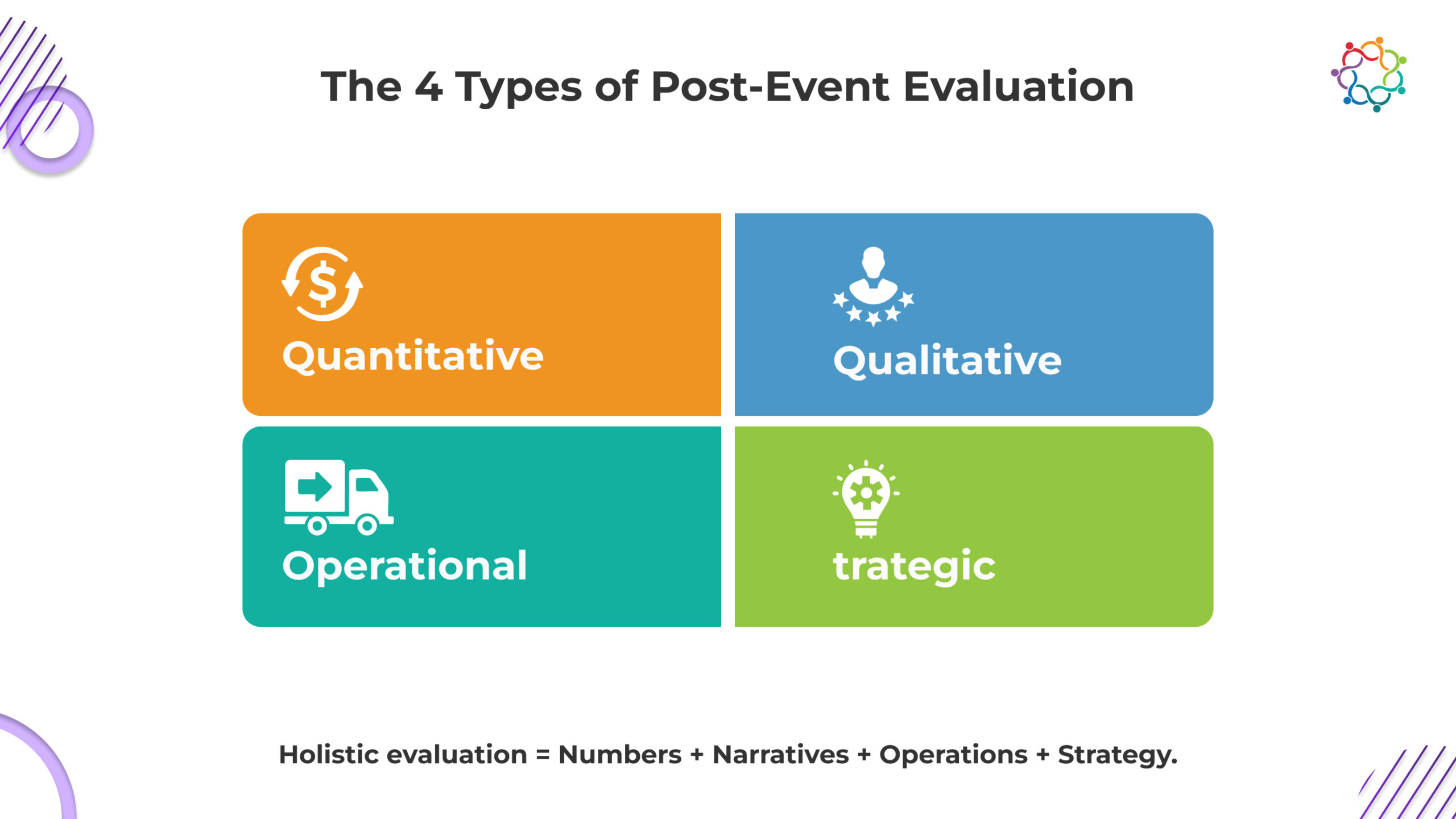
Your event is over. The last session has concluded, the lobby is quiet, and now the big question is – was it a success? For many teams, the answer is boiled down to one KPI, a total attendance number, or a quick NPS (Net Promoter Score). But events are layered, complicated experiences. Focusing on only one metric creates a flat incomplete picture; it leaves you with more questions than answers. You may have clarity on what happened, but you are not sure why, and furthermore, what it means for the future.
This is the reason a holistic approach to post-event evaluation is so important. It requires taking the event experience one step further and viewing it through multiple lenses. By identifying and applying the four main types of post-event evaluation, you can clarify your evidence from a complete picture; one that is not only going to help you determine your next steps but also increase your chances of securing budget next time and demonstrate the overall value of the experience. This blog will breakdown the various methods of event evaluation, outlining when and why one will be an important piece of your event reporting framework.
Quantitative evaluation is likely the most well known and easiest to process of the four assessment types. Quantitative evaluation simply deals with numerical data and measurable outputs. This is where the heavy, data-based data deals have started. These are things you can count. This information is objective, comparable, scalable, and directly measurable to consumers, stakeholders, and executives.
Quantitative data tells you what happened, while qualitative evaluation tells you why. This method seeks the stories, feelings, and perceptions of attendees, adding a human context to that data. It allows you to actually hear from your attendees in their own words and provides additional insights that data cannot illuminate.
Operational evaluation is an internal evaluation process that focuses purely on your event’s logistics including how it was executed. The goal of operational evaluation is to establish what was executed well and what wasn’t, so your team can learn from the experience so that they can inform capability and refine the process for the next event.
Strategic evaluation looks at your event holistically and examines the longer-term outcomes. It connects the event to higher-level business objectives. The focus is on the change in impact and lasting influence the event had, as opposed to short-term outcomes. Strategic evaluation is the most developed and therefore most challenging type of post-event evaluation, as it may be difficult to establish during the engagement level of an event.
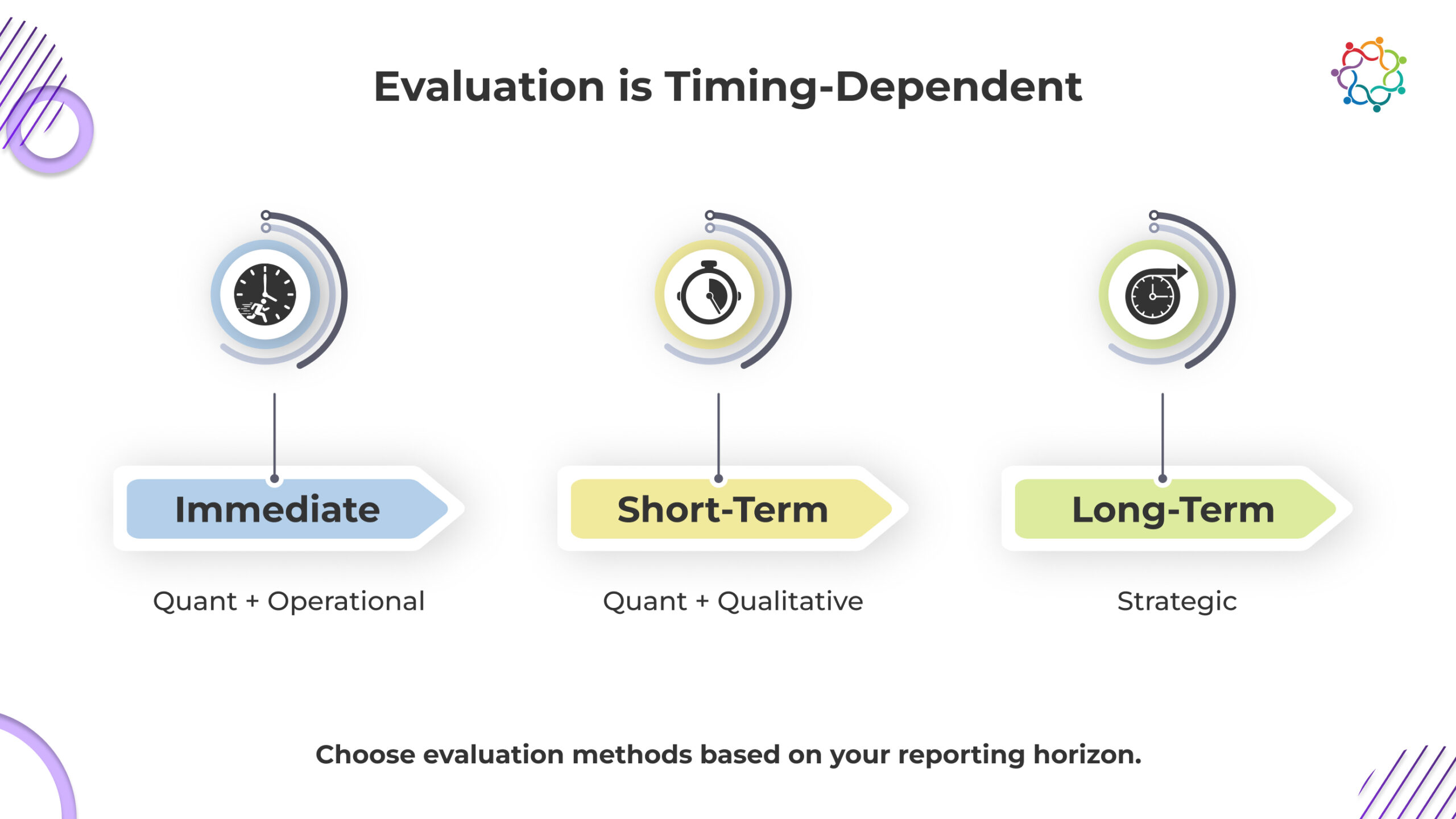
The best approach to evaluation is to take a blended approach to evaluation, depending on your goals and schedule. No single event evaluation approach will suffice alone. Here is a very simple approach to take:
The best practice is to always take a blended approach to these types based on your specific goals. For instance, if you are trying to demonstrate ROI, you will need both quantitative data on pipeline generated, and qualitative feedback from sales teams on the quality of leads, to be able to provide a compelling full-circle story.
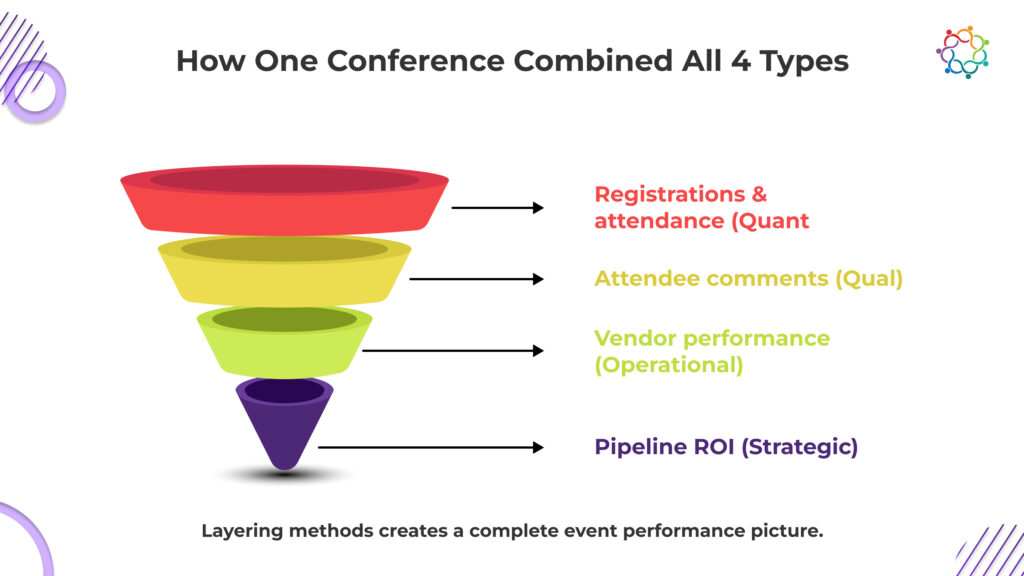
Now imagine a B2B event that used the universal evaluation framework. The team did not just use the evaluation to investigate the 1,500 participants but designed their evaluation to identify the full context.
Samaaro’s platform is built to be an all-in-one platform that facilitates every type of post-event evaluation. Our strong tools push you beyond the basics so that you can gather a more complete picture of your event’s outcome.
In an era of flawless marketing accounting, it’s crucial that your event evaluation practices are as sophisticated and multi-dimensional as your events are. By only measuring a multi-dimensional experience by one key performance indicator (KPI), you are underestimating the potential insights. Enter the realm of all four event evaluation types – quantitative, qualitative, operational, and strategic – and you will leave an event with a full circle understanding of the performance of your event.
Using a full circle approach will not only help you demonstrate the value of your previous events, but it will also provide the actionable intelligence needed to design and implement future events that are more successful, impactful and relevant to the business objectives of your organization.
Ready to learn about a full circle evaluation framework, download our Post-Event Evaluation white paper, or learn about Samaaro’s evaluation tools that do it all.
B2B events aren’t simple standalone experiences. They travel along extended sales cycles, interact with multiple stakeholders, and layer objectives from lead generation to thought leadership to customer retention. Whereas with consumer events ticket sales or footfall might be the primary mark of success, B2B event success is multidimensional.
That is why having a structured evaluation process is essential. If event teams have no framework for evaluation, they have the risk of drowning in unconnected numbers and anecdotal feedback. But with a structure, marketers will be more effectively able to connect event performance back to business objectives, validate business ROI to leadership, and continually enhance strategy for future events.
You should think of evaluation as the last component of the event lifecycle, the connection between what you executed, and what you are going to do better next time.
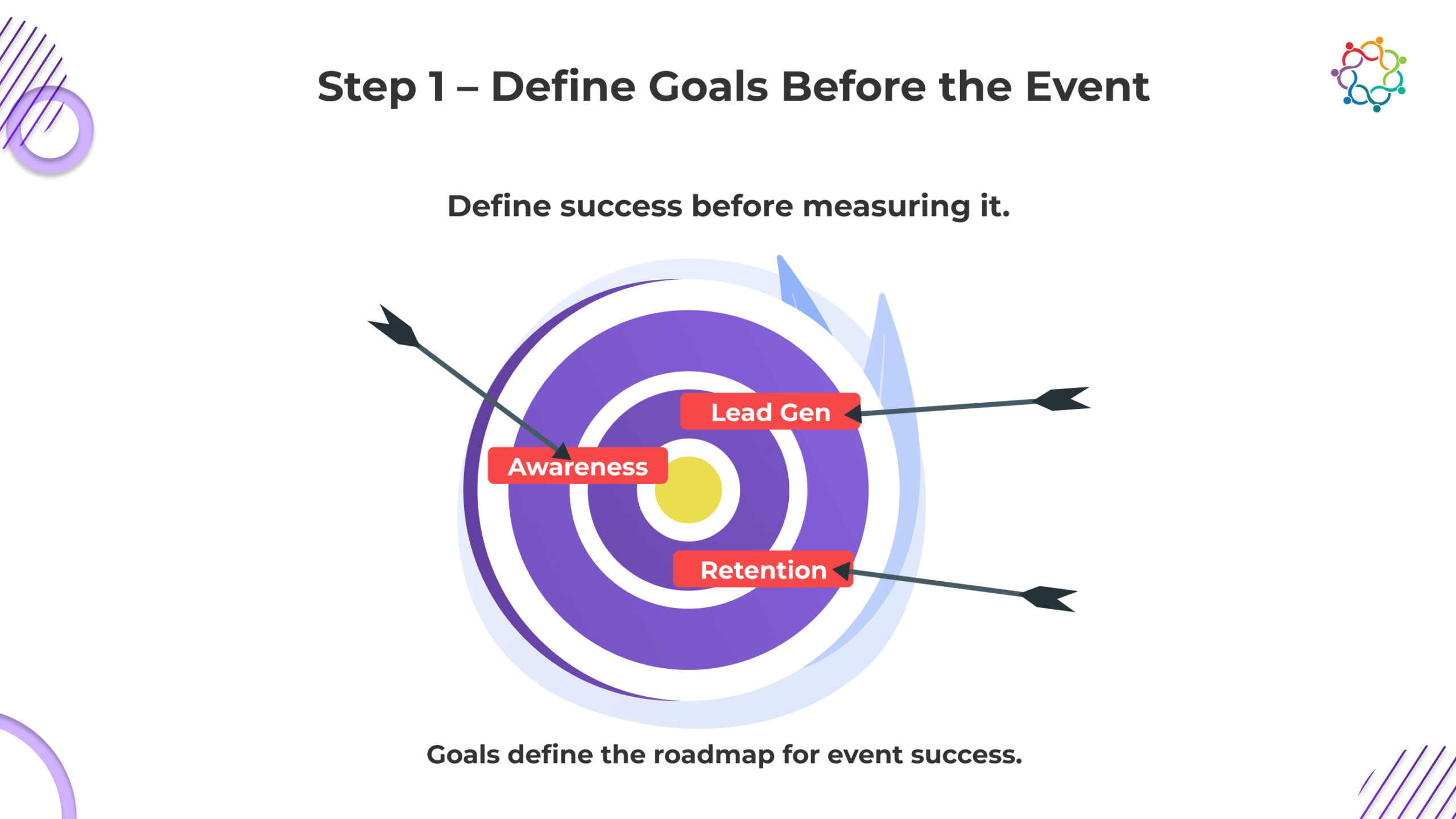
Evaluation doesn’t just start at the end of the event. It starts before you even promote. For the report to have meaningful impact, goals must be clear from the outset.
For B2B marketers, goals typically fall into three high-level categories:
A clearly defined goal is your North Star. Without a clearly defined goal every metric becomes noise.
Quantitative data will answer your “what happened?” It provides measurable, objective signals of performance.
The fundamental quant metrics to track for B2B events are:
These numbers are a starting place for evaluation but as much as the data helps, it does not tell you why the impact what it was.
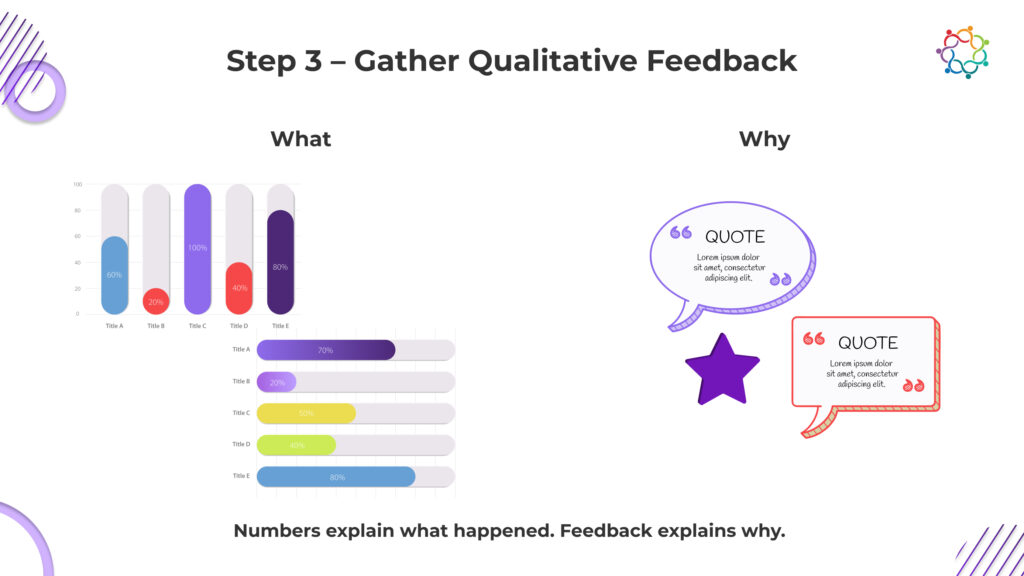
Data can indicate 300 attendees joined the webinar but only by way of qualitative feedback do you understand if it was thought of value.
Some core qualitative inputs are:
This feedback layer allows cold numbers to breathe and provide meaning. It adds human context to measurable outcomes.
This is where the process changes from collecting data to interpreting findings. Numbers without context can be misleading and stories without data can lead to bias in decision making. The most effective analysis combines quant and qual.
For example,
So, both are providing clear and actionable advice: rethink the content design, for your technical sessions.
At this stage it is also important to reflect on the outcomes in relation to strategic targets. What was the impact on key accounts? What was the reach in target markets? Did you generate enough qualified leads to warrant the expense?
The last step in evaluation is not the report, it’s the playbook. I have tried to distil out lessons so that those lessons are not just captured in a file but rather are clearly understood lessons that will play in the next campaign.
Best practices in the playbook:
This step is intended to take evaluation from a process to a system of ongoing improvement in that each event leads to a smarter next event.
Even seasoned/practice teams experience challenges when evaluating their events. Some very common things not to do include;
Avoiding these mistakes means that you are positioned to evaluate strategically, as opposed to superficially.
Evaluating using separate spreadsheets, survey tools, and CRM exports is not an efficient use of resources. Enterprises need a single system that can align steps accordingly.
Samaaro provides that:
Instead of amalgamating multiple data points, Samaaro provides a step-by-step evaluation framework in one platform making it easier for B2B teams to engage in systematic evaluation.
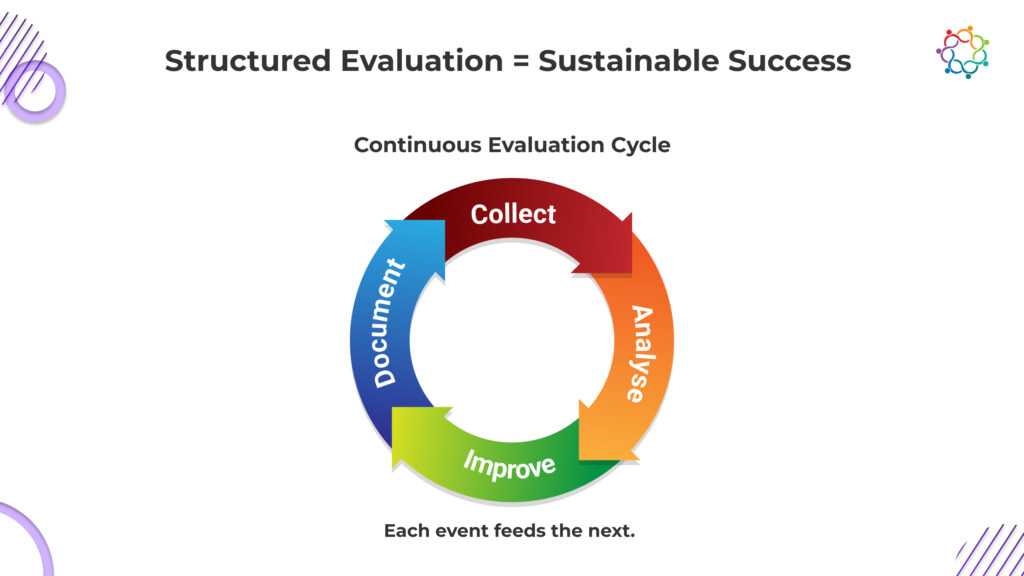
Event evaluation is not just a new step in the journey; it is the difference between one-off activities and a scalable growth engine.
For B2B marketers, a step-by-step evaluation framework:
Event and marketing teams can run outcome evaluations smarter, faster, and impactfully. So, that every event is not only successful but executes the enterprise strategy supporting that success.
Don’t want to build your own evaluation process? Ready-made evaluation frameworks are available in the form of a downloadable Post-Event Evaluation white paper or check out Samaaro’s analytics which every enterprise should consider.
Every marketer knows that channels are important, email, social, ads, partnerships, they all matter. But one of the biggest factors that differentiates good events from poor ones is not channel, but rather timing.
If you launch a campaign too late, you won’t have enough time to generate awareness. If you push too hard at an inopportune time, your audience may tune out. And if you wait until the last minute, even the most polished campaign will probably not convert.
That is why the promotion timeline is just as important as the channels. For B2B firms when events usually have expensive budgets, valuable leads and long durations of decision making, timing is strategic in the sense that taking a more sequential approach can help create consistent momentum for prospects moving through each stage, awareness, engagement and finally action/purchase.
This article shows the three critical event promotion phases- Launch, Ramp Up and Conversion, and helps to show how to avoid wasted budgets and lost ROI due to timing.
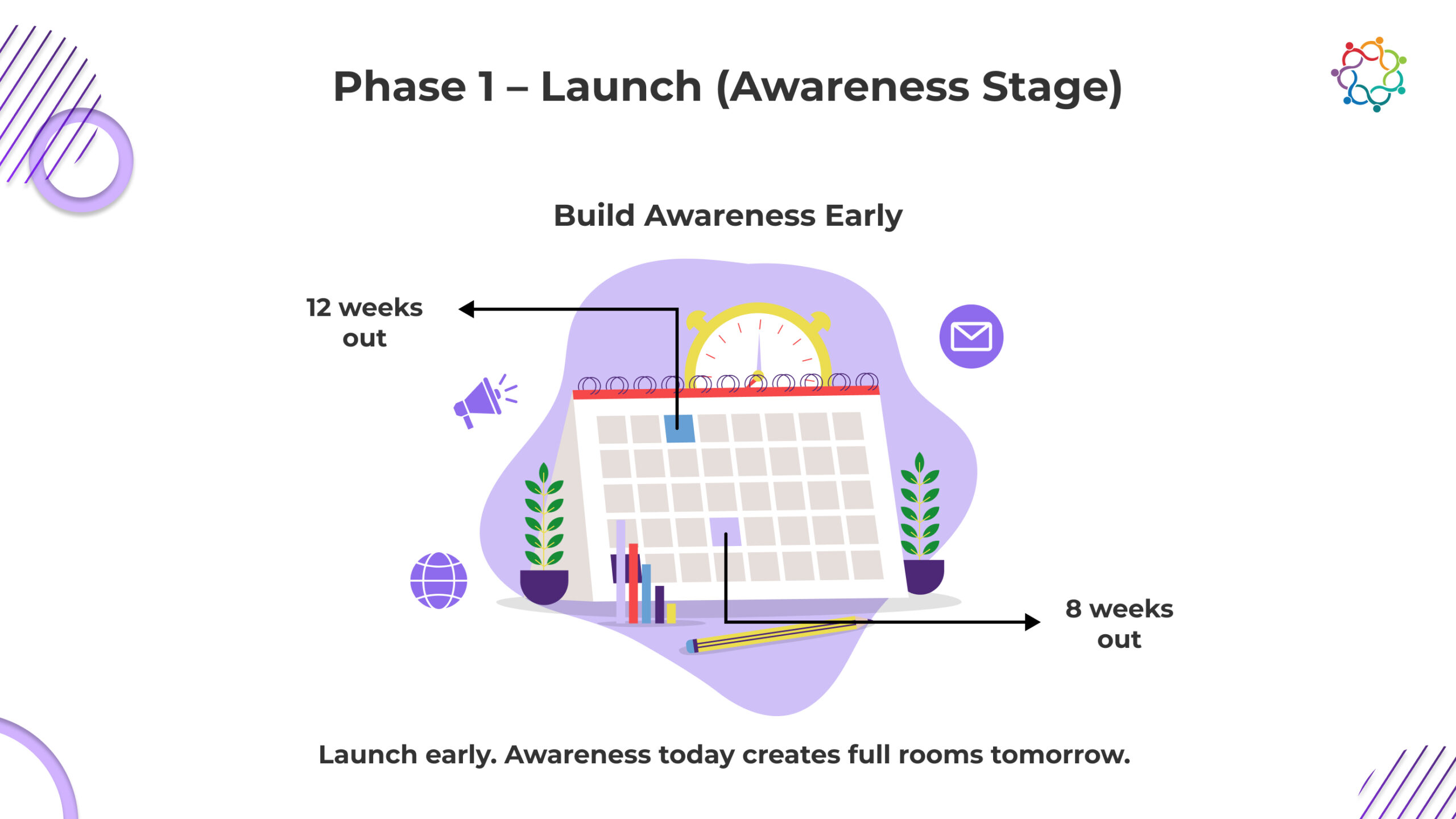
The first step is planting the seed. Your audience does not need much information at this stage. They only need to know:
This is where you create excitement. This is where you start building your credibility.
Some things in your Launch phase:
Why It Is Important:
Enterprise buyers and decision-makers need time to block out their calendars – budgets are often determined months ahead. If you do not notify them early, you risk the chance of them tying themselves to another event.
Think of this as your awareness window. You will hopefully get them curious and stop them from blocking off that space in their minds for competitors.
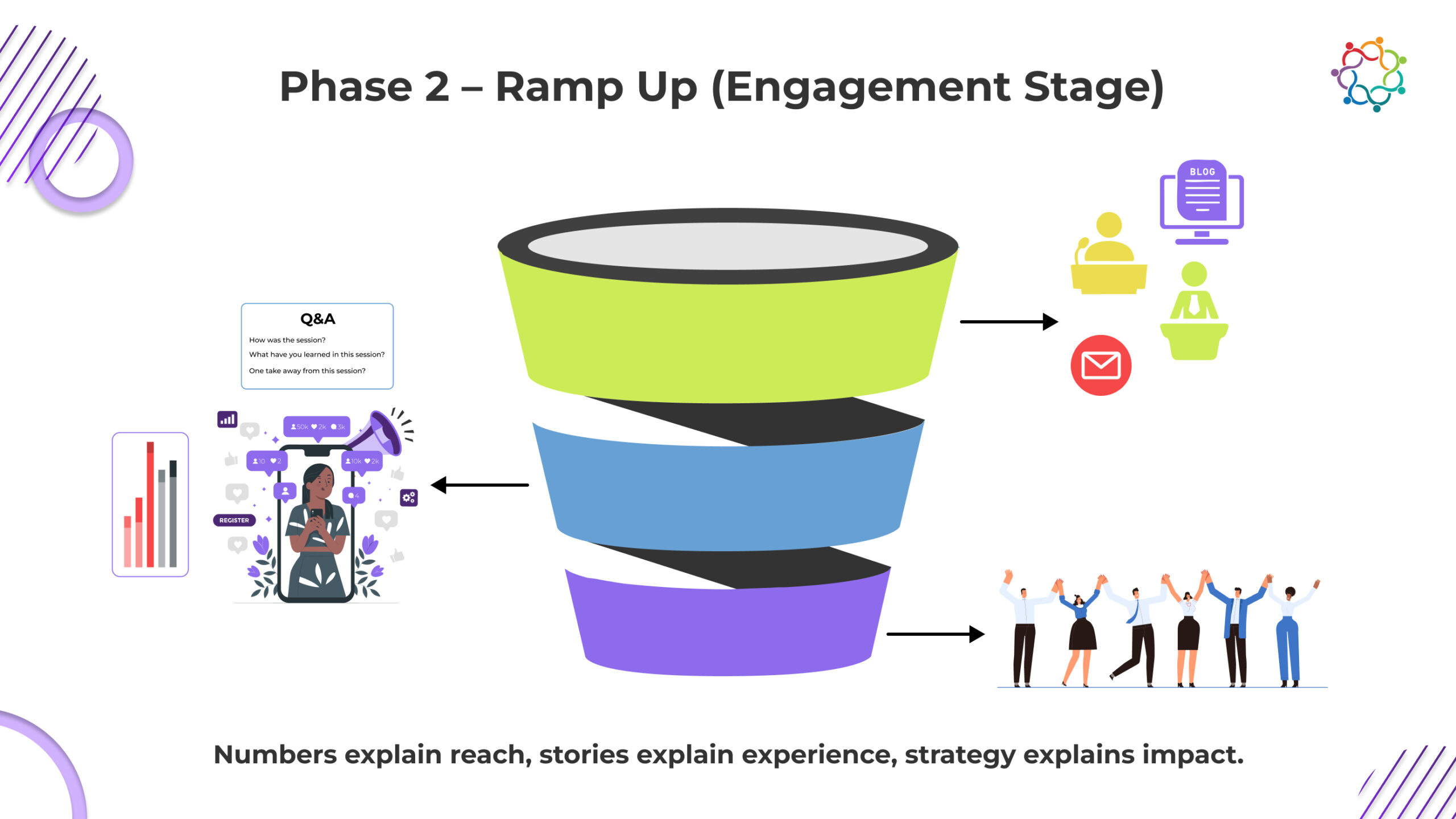
Once awareness is created, it’s time to give your audience reasons to care. The Ramp Up stage of engagement increases the depth of engagement with your audience by providing content, value, and inviting them to participate.
Key activities in the Ramp Up Stage:
Why is it important?
In the middle stage is where participants will internally develop their perspective on why your event is worth their time. Without having truly developed an audience engagement strategy the awareness that was generated in the first stage, will fade away. Start with content rich previews of your event so that potential participants can decide it is not merely happening, but valuable and cannot be missed.
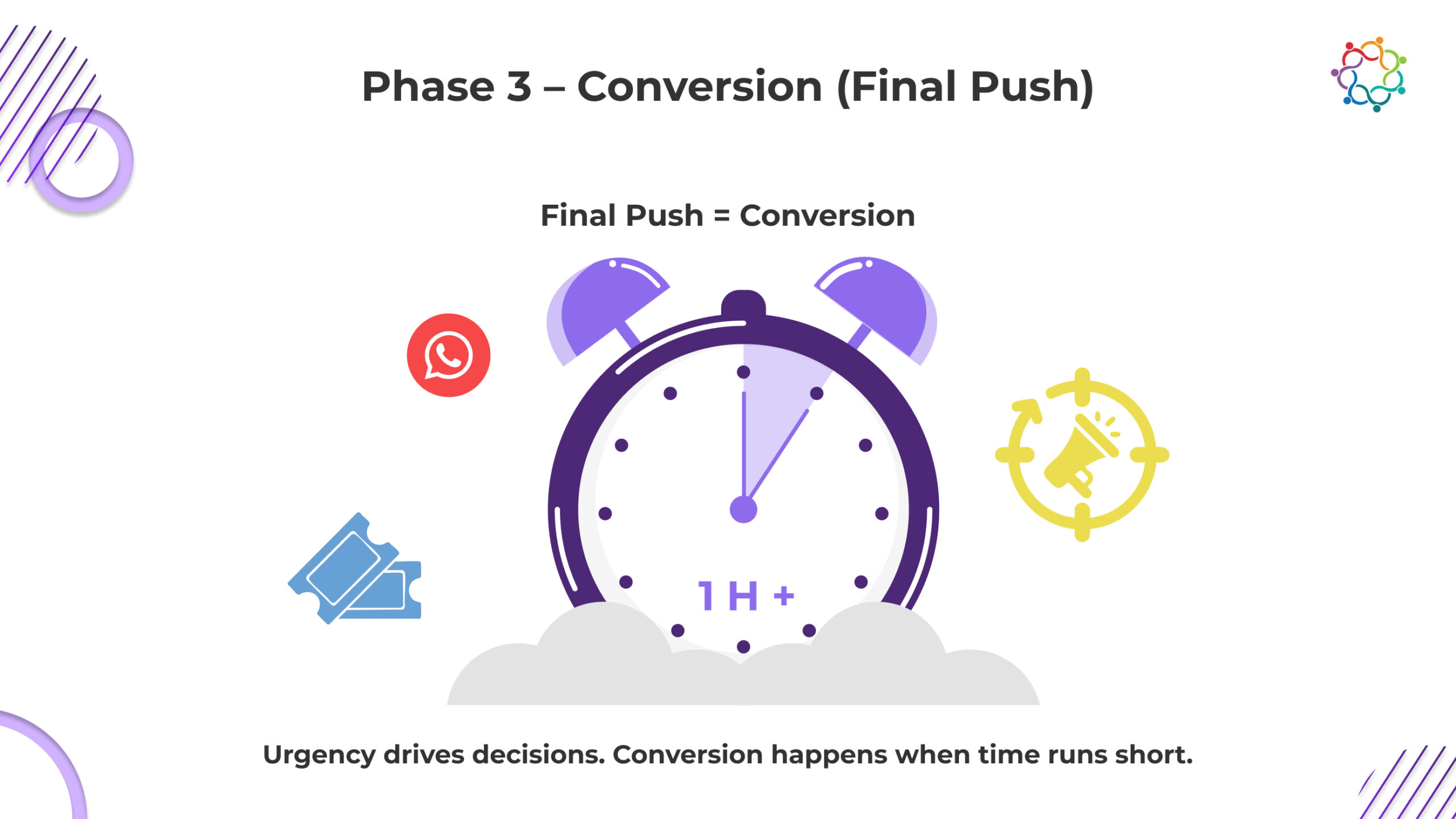
This is where urgency will serve you best, the Conversion Phase is all about taking engaged prospects and converting them into confirmed attendees.
Key Activities in the Conversion Phase:
Why This Is Important:
Engaged audiences will procrastinate. So, a final push may be just what it takes to ensure they don’t wait until it is too late. The Conversion Phase helps give your audiences something that helps differentiate between “interest” and commitment.
Promotional timelines aren’t inherently bad; however, they are mismanaged more often than not. These behaviours are often the fatal flaws of even the best-funded promotional campaign:
Take away? – Timing is not so much, guesswork, it is pacing.
Samaaro assists enterprises in implementing these principles using:
By aligning timelines with channels, Samaaro guarantees that promotion campaigns will not only run, but run strategically.
Event promotion isn’t just about how many channels you use or how much budget you spend. It’s about when you act.
The most successful enterprise campaigns follow a simple rhythm:
By treating timing as a strategic lever, you’ll maximize ROI, avoid wasted spend, and build momentum that carries directly into event-day success.
Want to optimize promotion timelines? Download our Event Promotion white paper or explore Samaaro’s campaign tools.

Built for modern marketing teams, Samaaro’s AI-powered event-tech platform helps you run events more efficiently, reduce manual work, engage attendees, capture qualified leads and gain real-time visibility into your events’ performance.
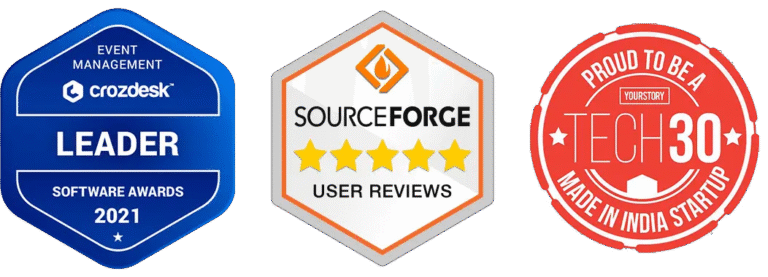
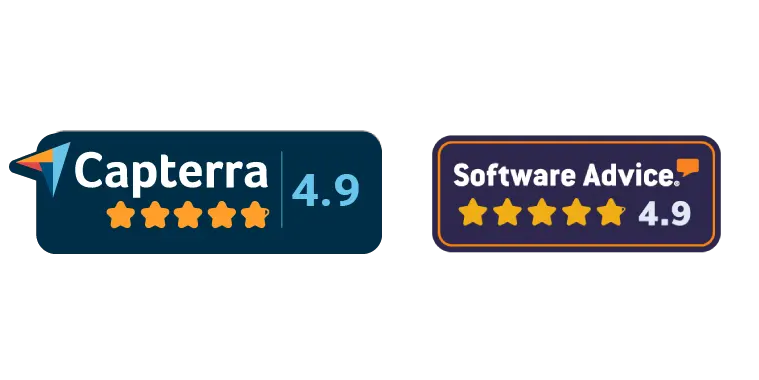
© 2025 — Samaaro. All Rights Reserved.